
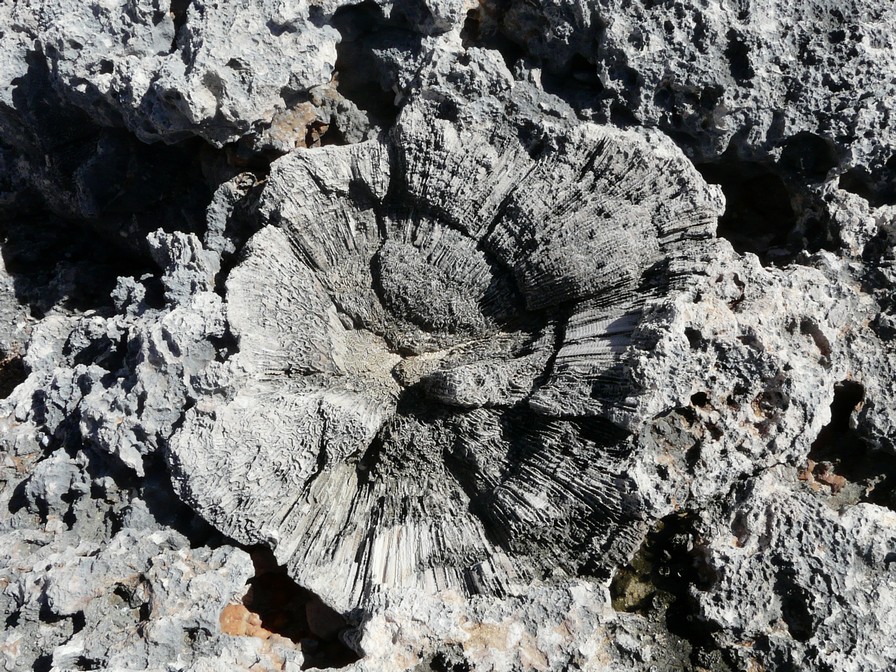




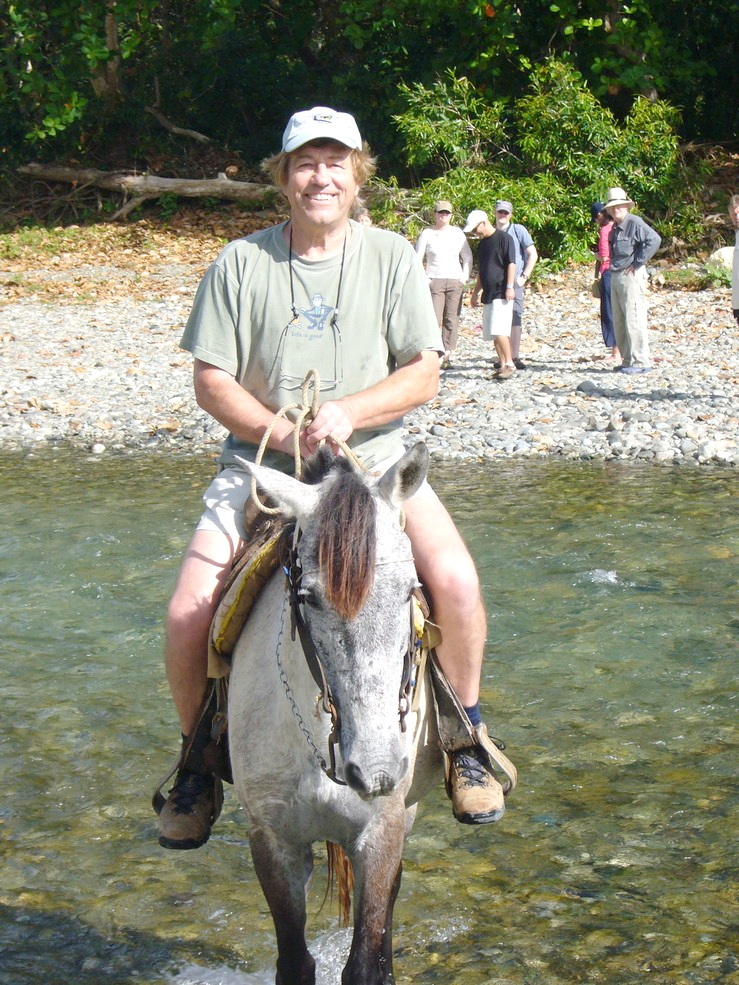
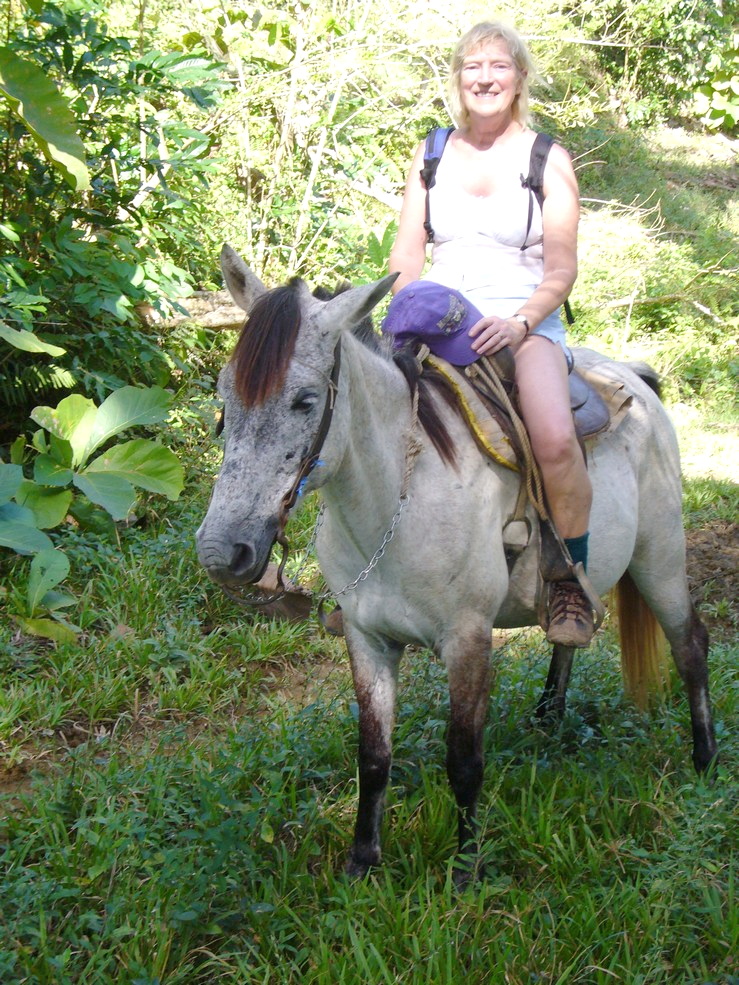
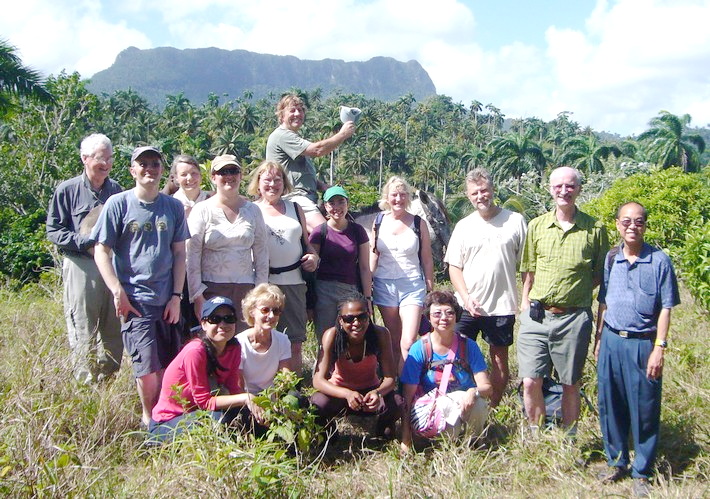
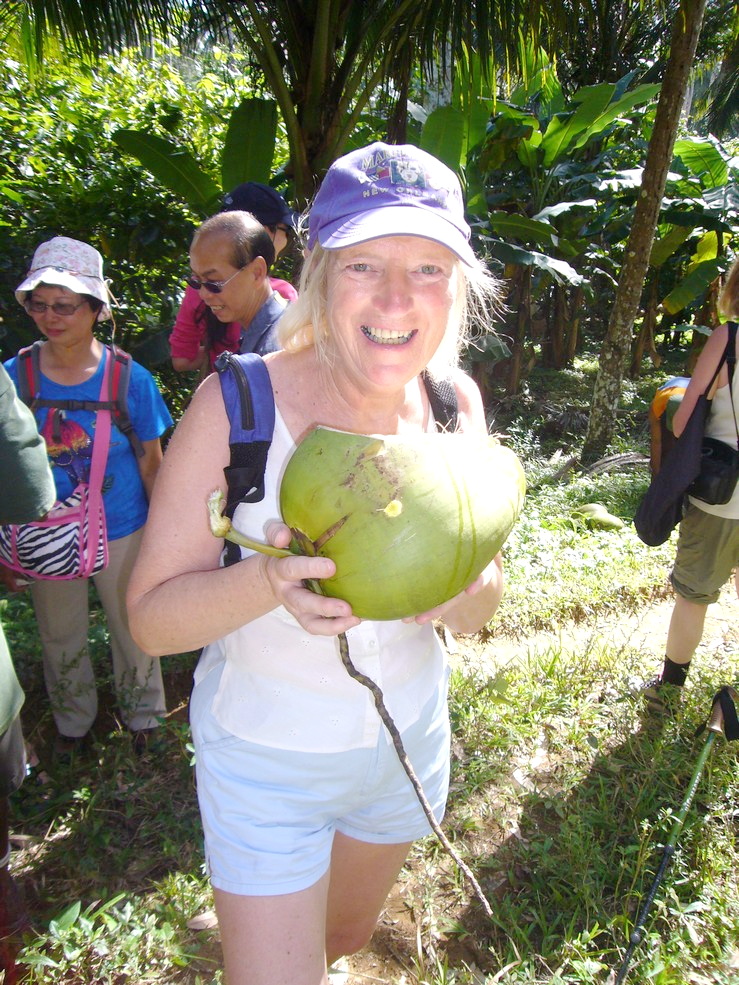
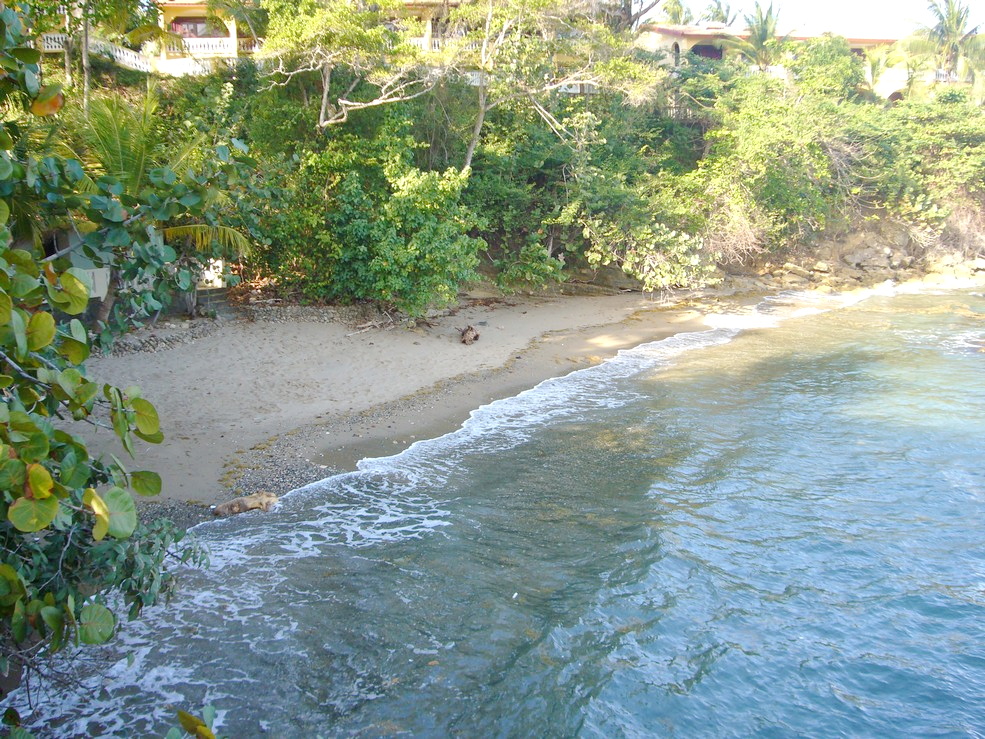
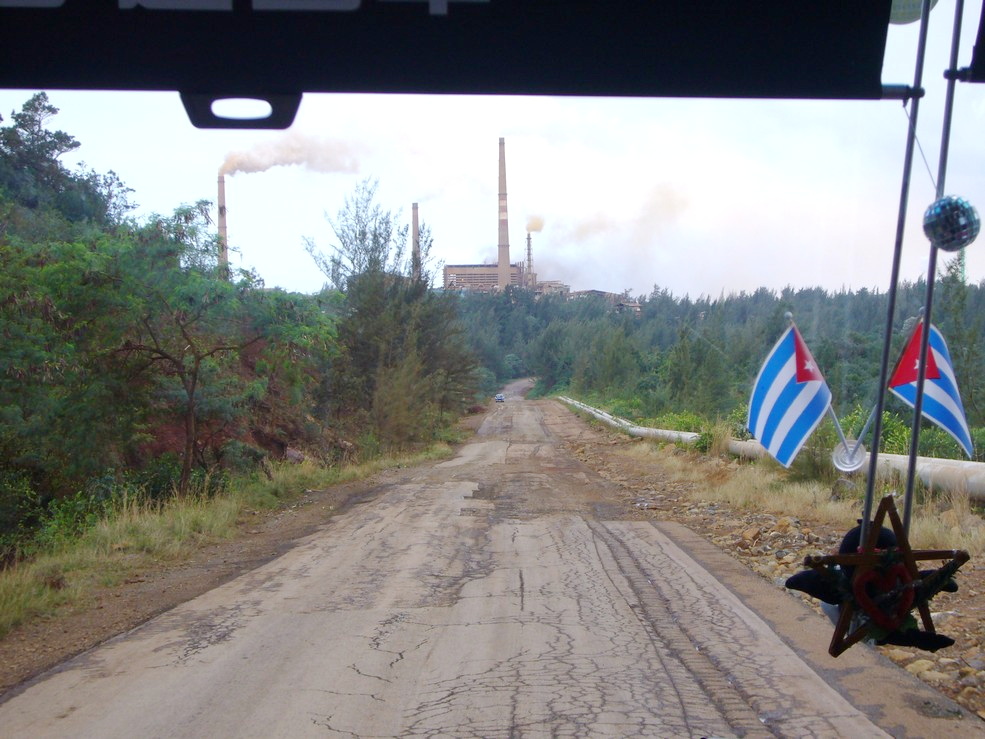
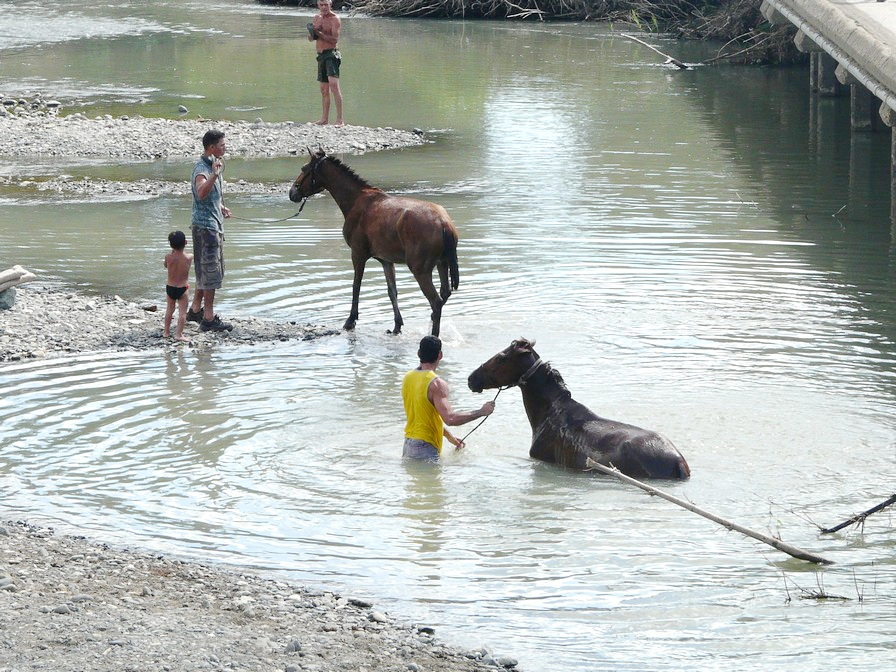




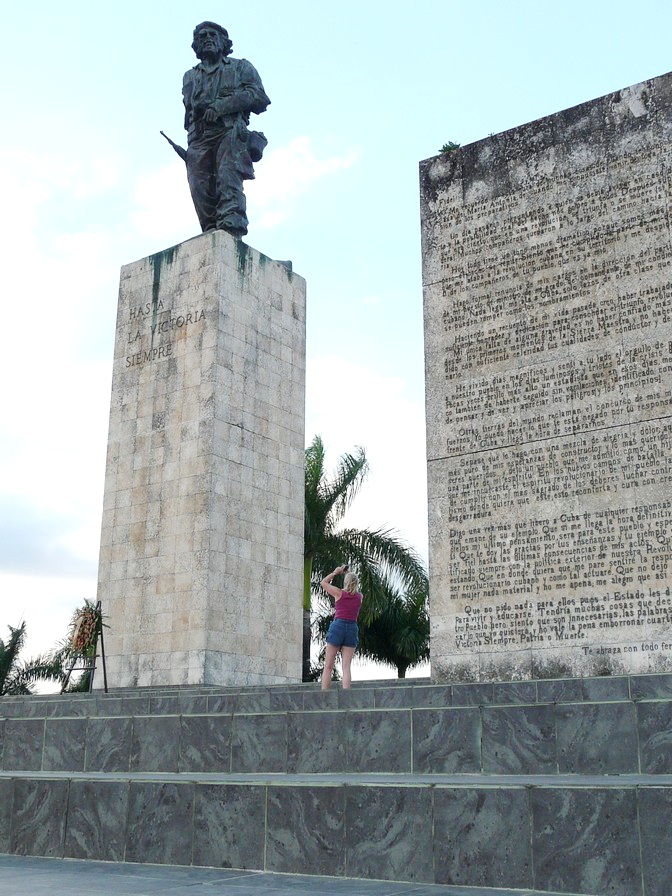
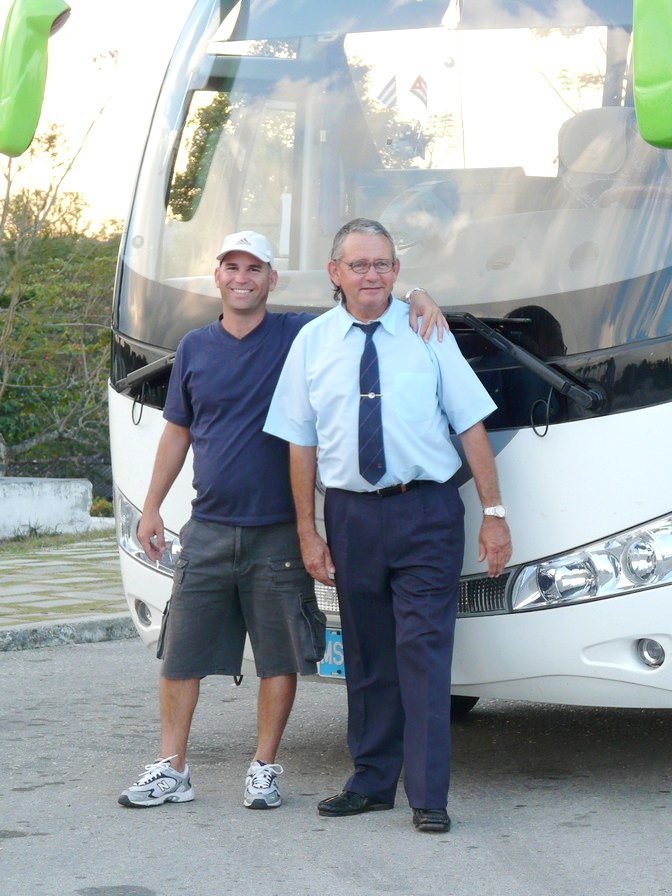
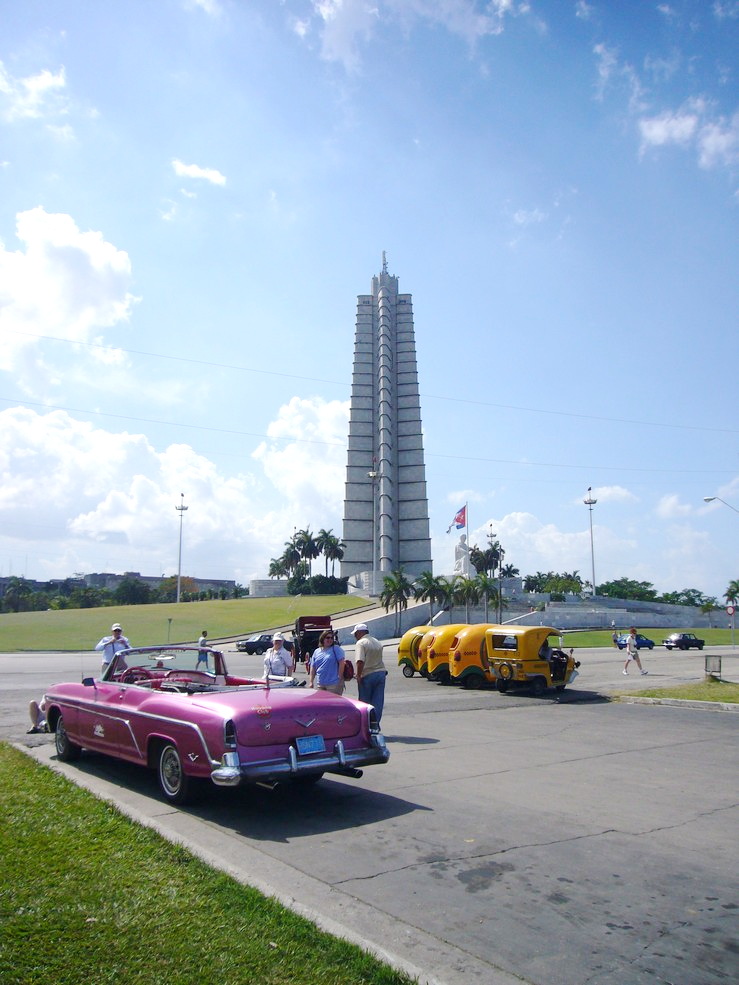
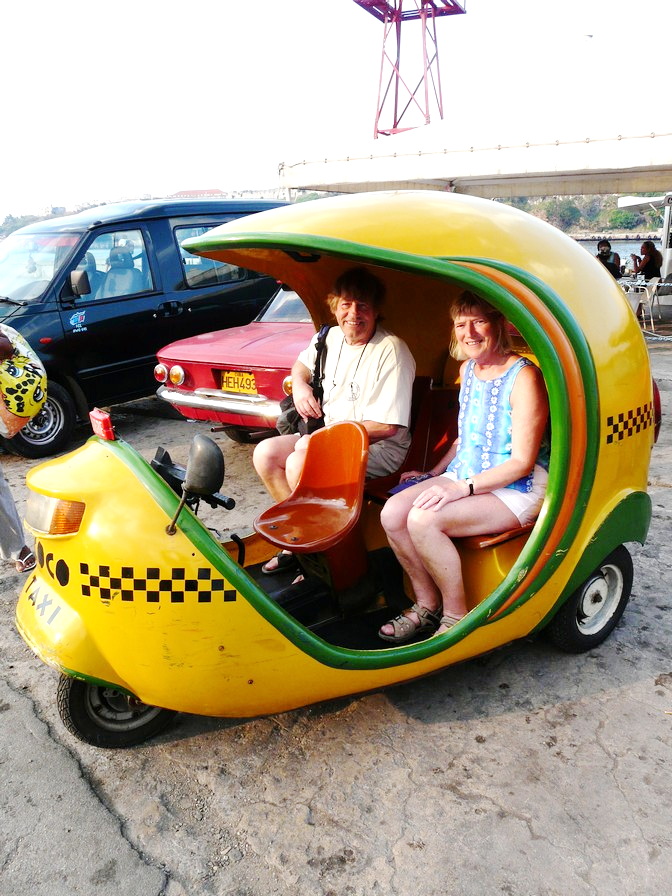
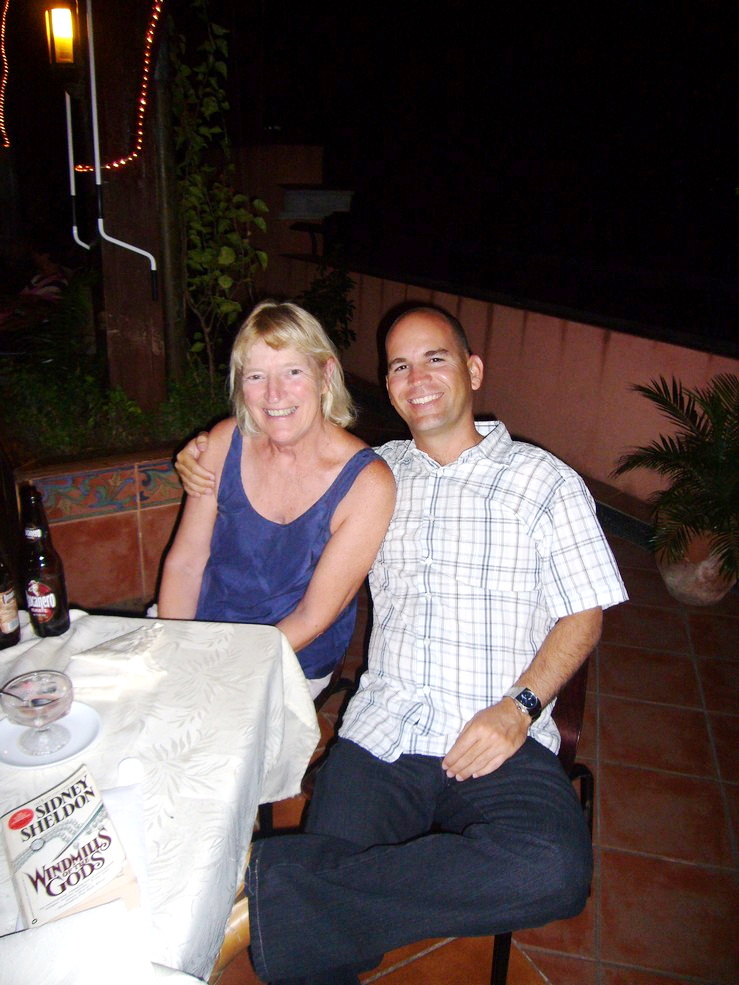

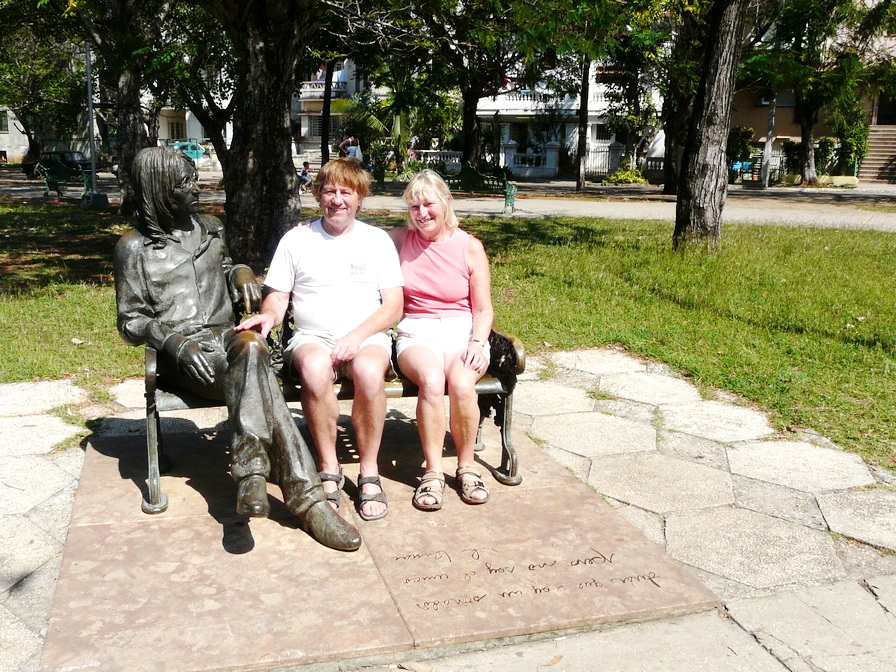
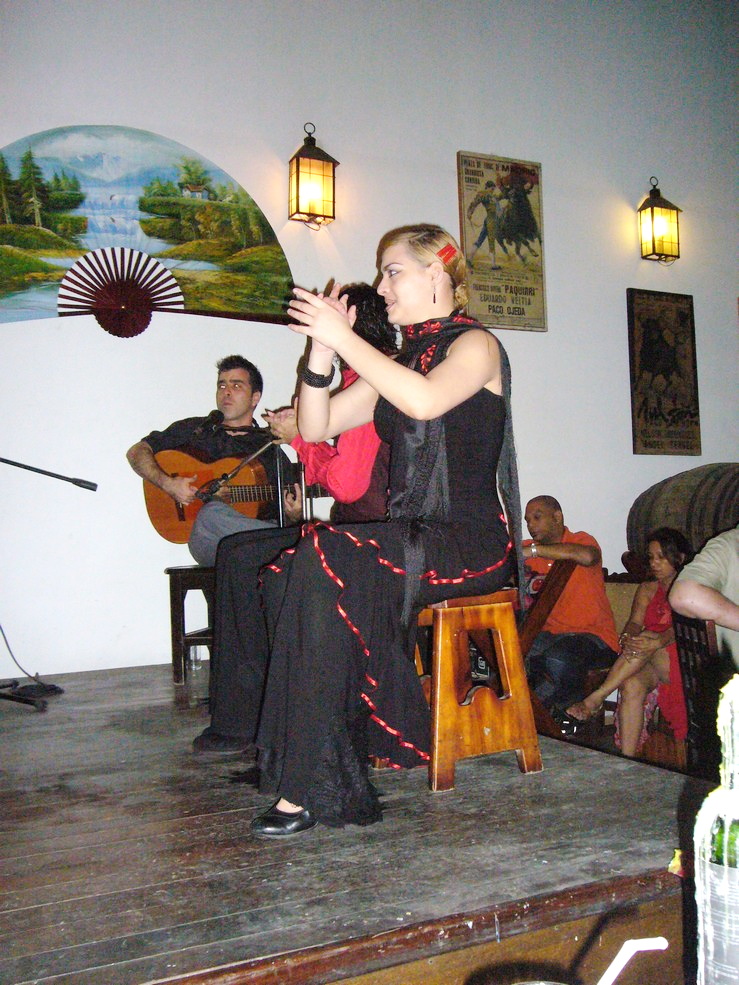
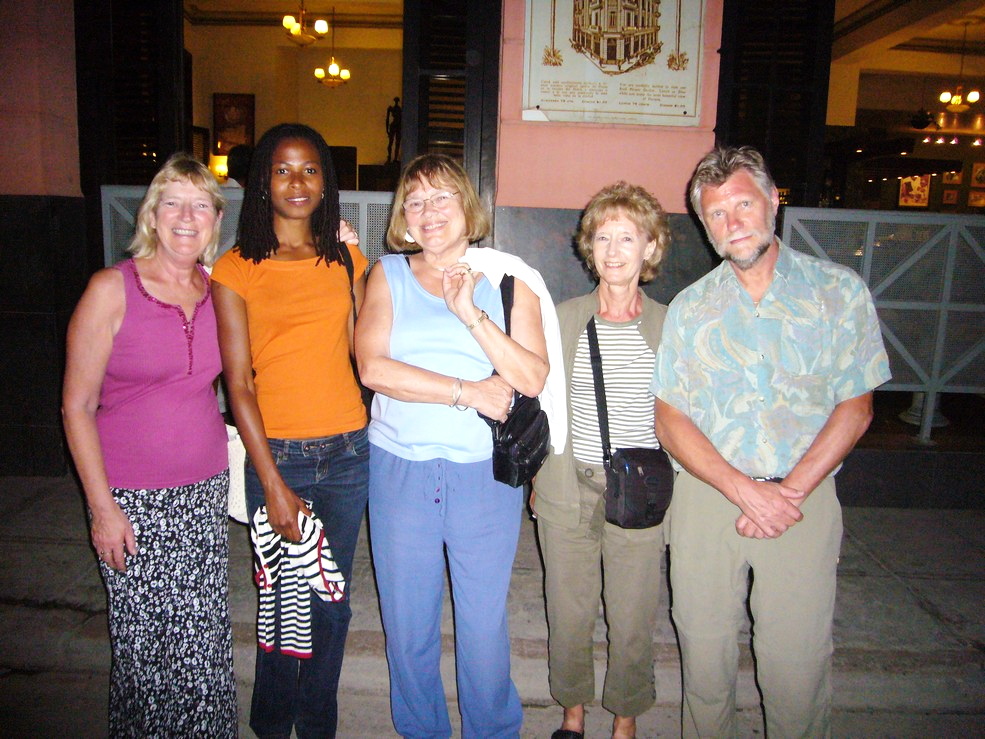
Cuba 2008
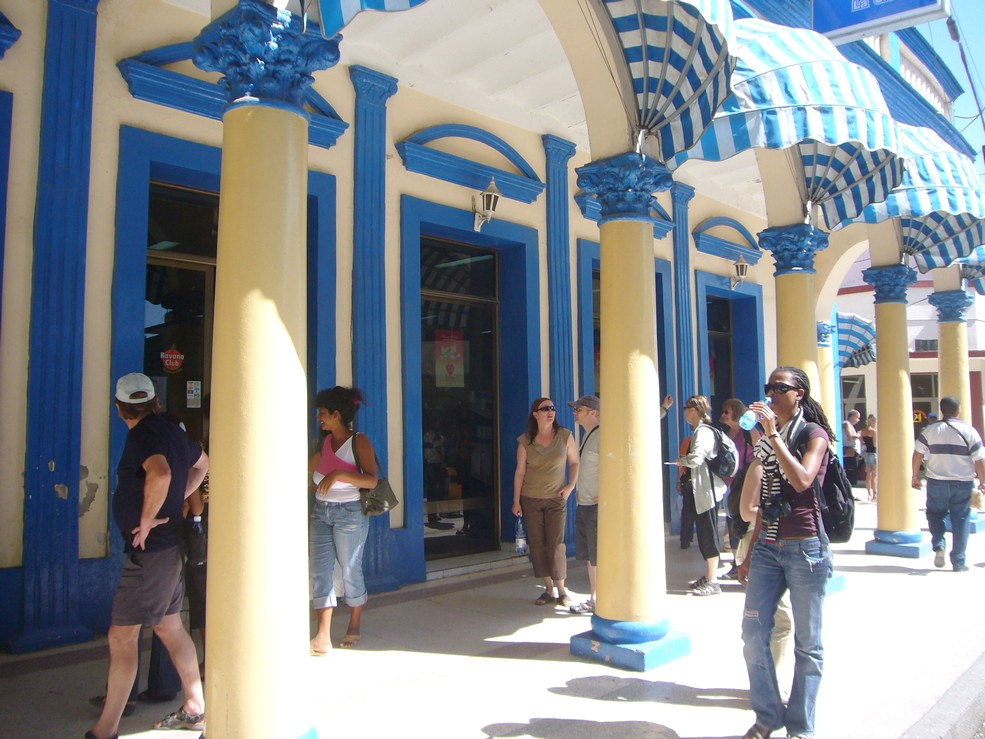

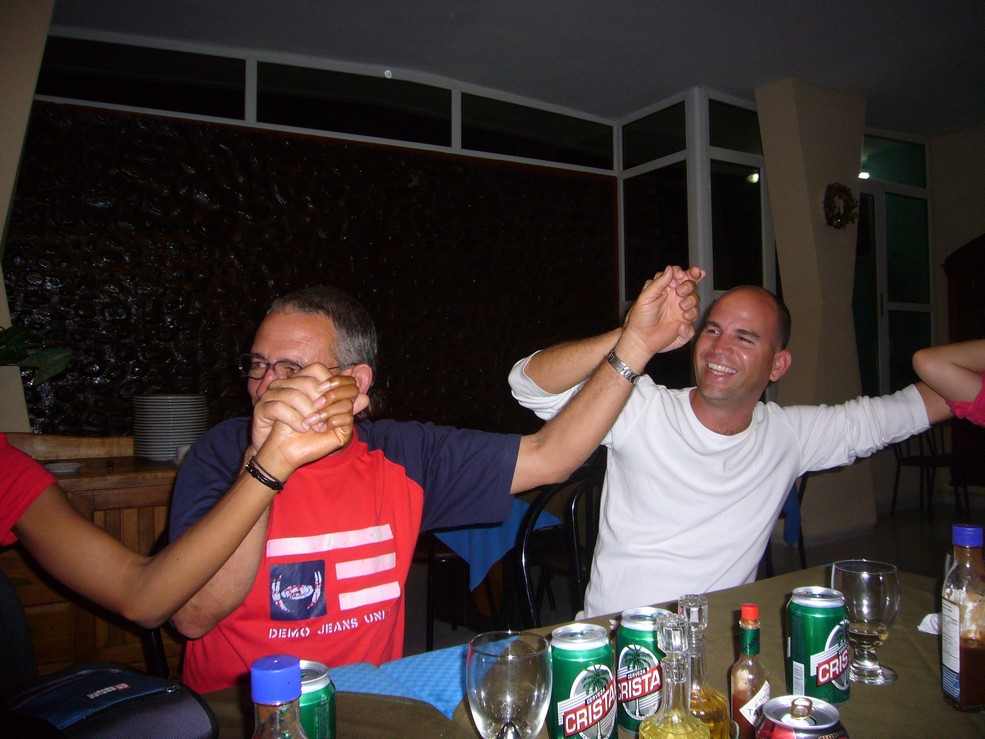
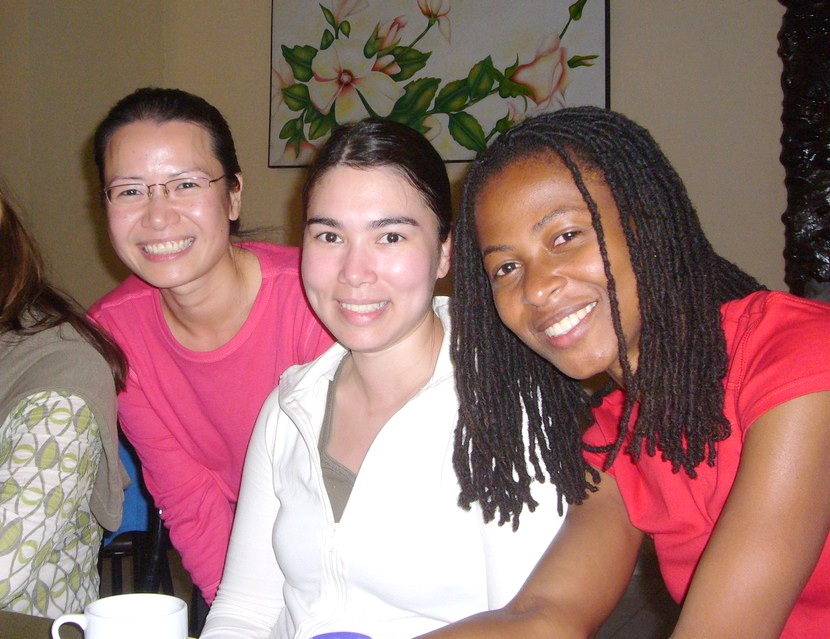
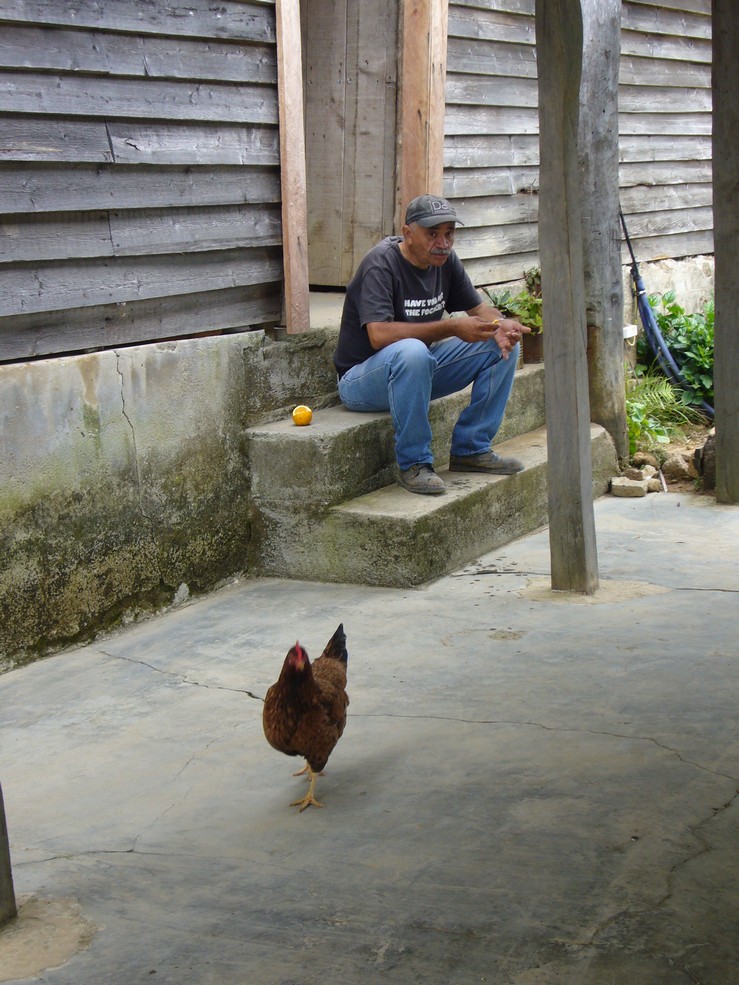
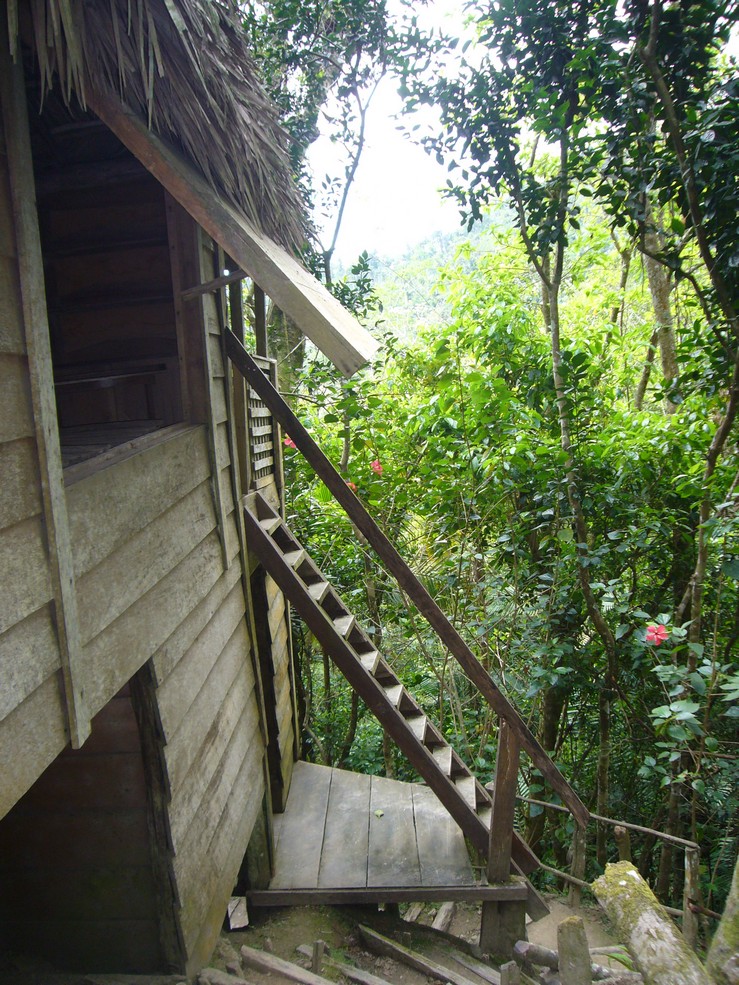
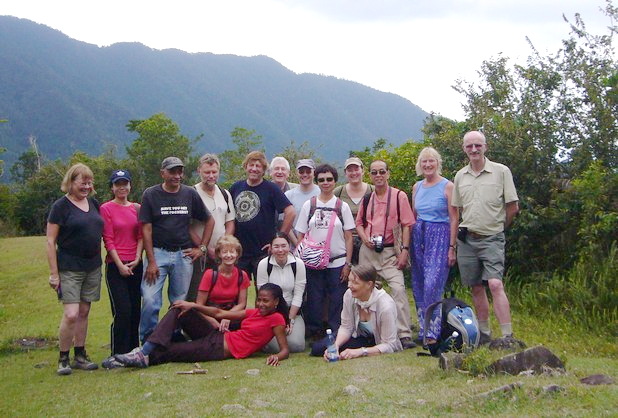
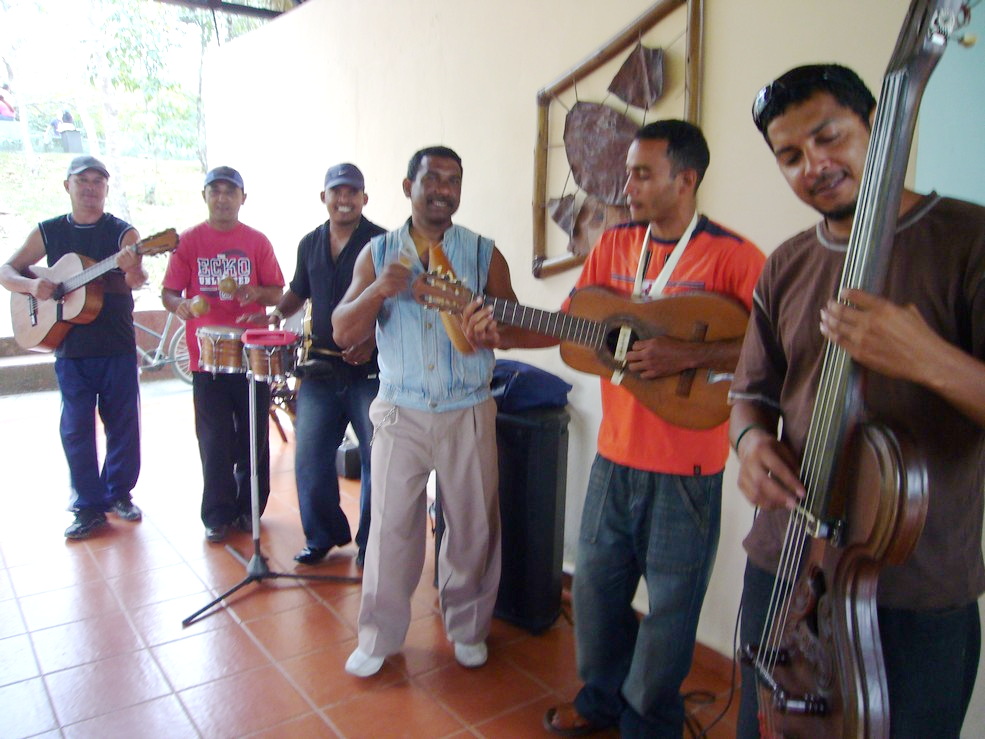


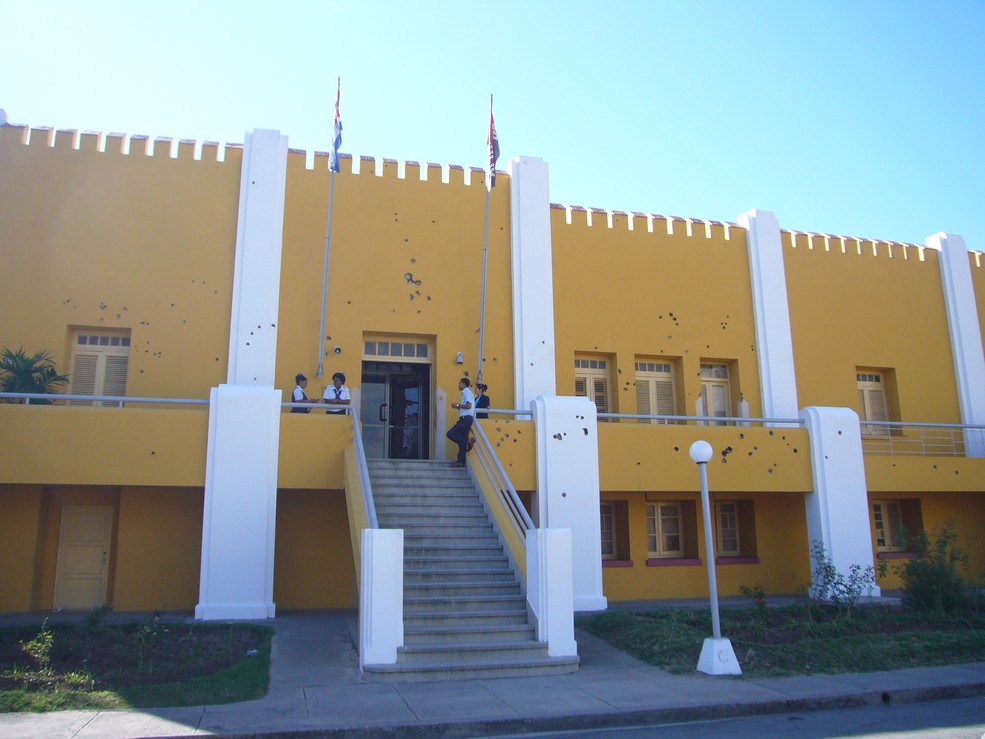
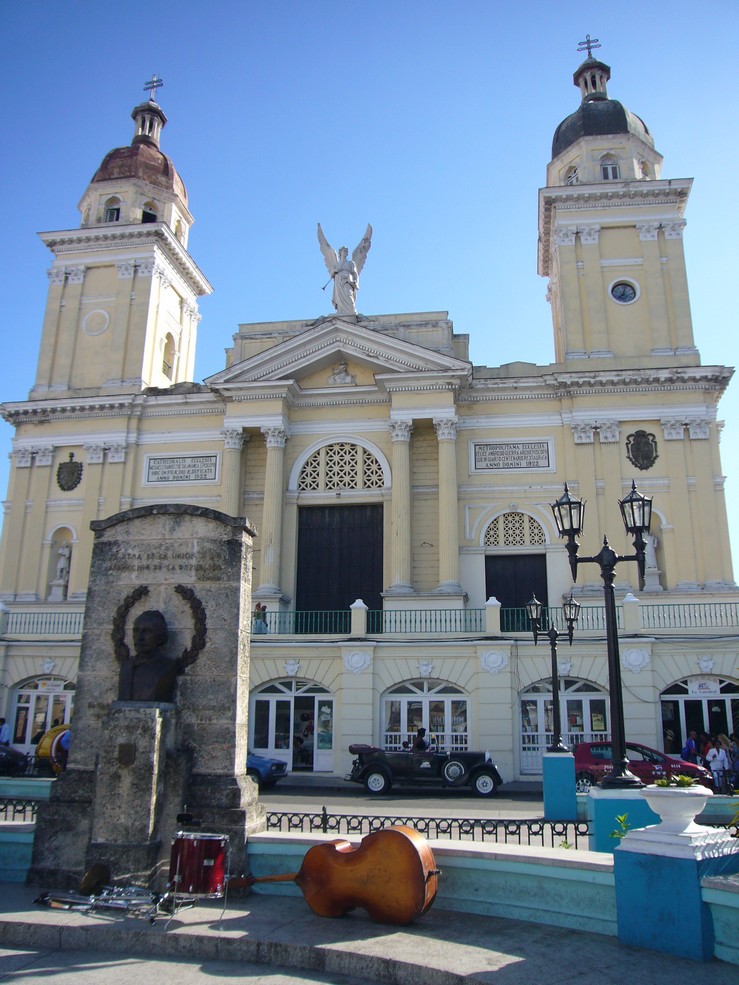
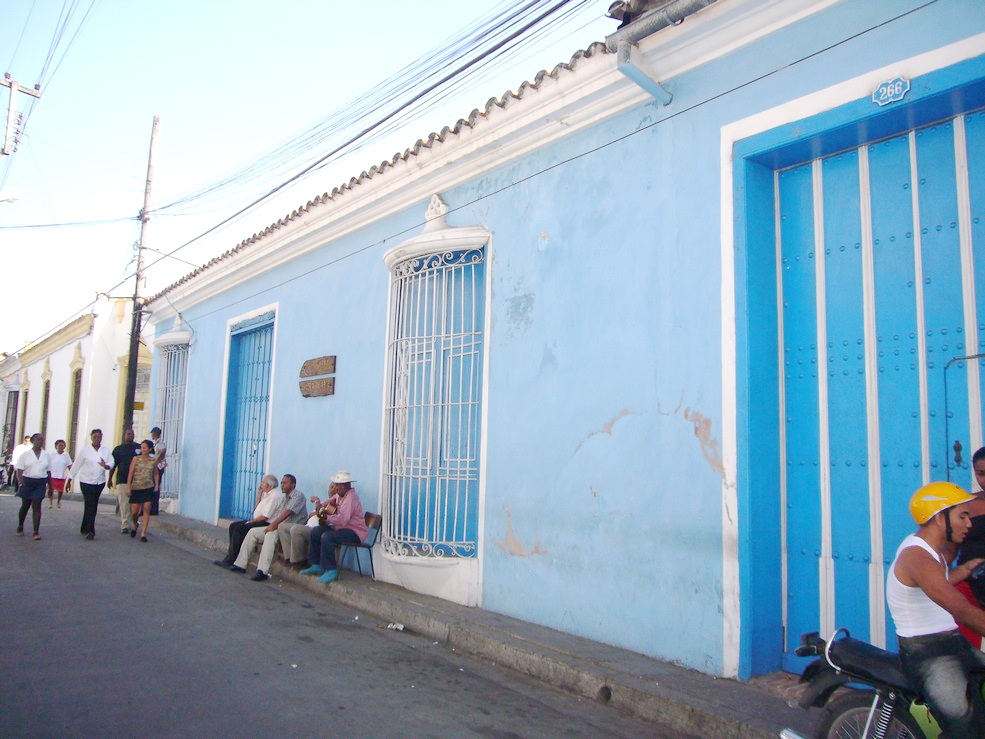
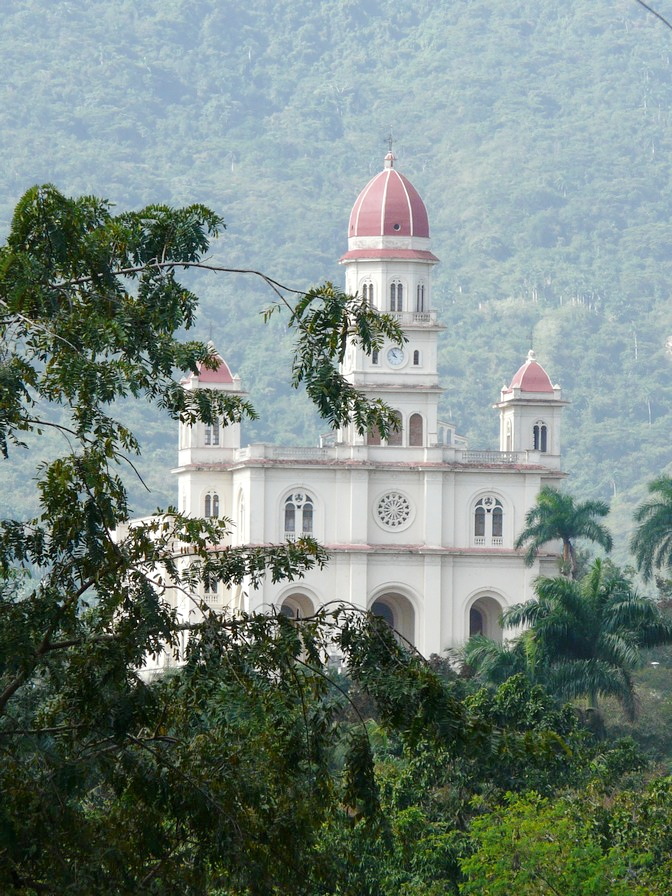
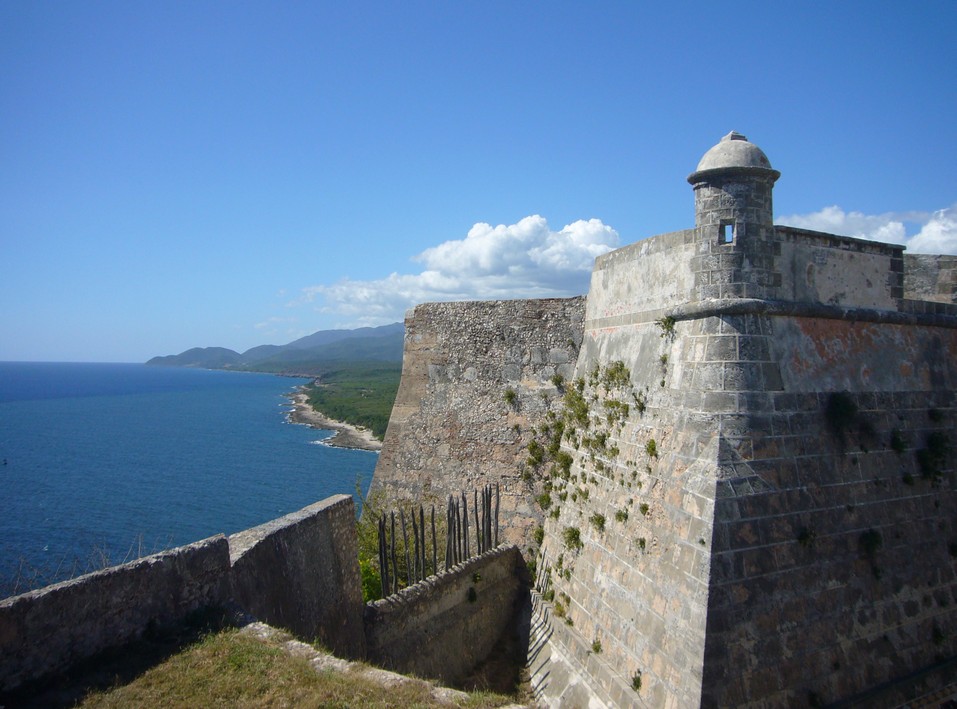
Thursday 31st January To the Sierra Maestra
The night was noisy with the hooting of trains, but also with sounds from below of talking (we were above the central courtyard). The breakfast wasn’t up to much, so we basically ate fruit. There is a lot of choice at most of the hotels, but nothing looks very appetizing.
We left at 9 o’clock, heading eastwards. As we went along, Alberto talked to us about transport in Cuba. State vehicles have blue number plates, and private vehicles have yellow. As no ordinary people can afford a car, a ‘hitch hiking’ system has evolved. Groups of people wait at junctions, and a ‘controller’ directs them onto passing state vehicles (but not tourist vehicles). A fee has to be paid, as on a bus.
Later he talked to us about education, which is compulsory and free. The literacy rate is an impressive 98%, but there are not enough teachers as the pay is very poor.
The same is the plight of doctors, many of whom work abroad, where they can earn in 3 years what it would take 30 to earn in Cuba. Life expectancy is 76 years.
The road was often lined with the trees with pink blossom, which seem to sprout from sticks of them stuck in the ground (called in Spanish ‘well dressed tree’).
We stopped for coffee at a wayside café, where several men were trying to erect a statue of Jose Marti, He didn’t look very elegant lying on the ground!
We stopped at the town of Bayamo, which dates from 1513, the second oldest in Cuba. It was the birthplace of the composer of the Cuban National Anthem, Figuerado, and also of Carlos Manuel de Cespedes, the hero of the first war of independence, and known as the father of the country.
Lunchtime hotel, Bayamo
After a look around the main square, we had lunch in a pleasant hotel restaurant before continuing to our destination in the Sierra Maestro. The road for the last few miles was extremely uneven. We reached the hotel Balcon de la Sierra, near Bartolome Maso at 4 o’clock. The setting was delightful, looking out over the mountains, but when we were finally allotted our room, unlike most with private patio/balcony, ours was dark and dingy. This was a huge disappointment, but Alberto was quick to try to help. After a bit we were given a second choice, but this was directly below the first, with still no balcony. We were fortunate in being offered a third room, which did have a small balcony, but hadn’t yet been made up. I was really hot, so managed to locate my swimming costume and make for the beautifully positioned if grubby pool. There had been a sign saying ‘not in use’ when I first looked, but the man removed it, and I cooled down in the cleaner part of the pool.
All this time, Adrian had been busy talking to David, a former doctor, who seemed to agree that Adrian is suffering from a virus, which had been causing him to feel tired and listless all the time we have been away.
Once sorted, we sat out on our little balcony with a drink, toasting Simon (35 today) and Angela (65). Yesterday we had said cheers to Laure.
Being here made us think of Tahiti, with the tiny homes down beneath us, and the sound of animals (cockerels & pigs!).
We had a meal altogether in the ‘restaurant’, and were once more entertained by musicians.
Looking to Sierra Maestra
Fun at suppertime
Friday 1st February Castro’s headquarters in the Sierra Maestra
The night was hardly quiet, with noises of all kinds including cockerels.
Today was the day to visit the area of the Sierra Maestra where Fidel Castro had his headquarters during the time of the Revolution (Dec 1956-Dec 1958). After breakfast we were told to put our bags onto the bus, as we were to be driven by 4x4s into the mountains. We had a problem, as we couldn’t unlock our door! Last night we had come back from the meal to find the door open, despite Adrian thinking he had locked it, so today he’d slammed it hard! We had to get hotel staff to come and assist, and finally it was opened!
We were driven on really steep and winding roads to the entrance to Turquino National Park, which contains Mt Turquino, the highest in Cuba (1972m).
The scenery was like lush rainforest, with some beautiful flowers, and luckily today was fine and warm. We had to pay $5 to photograph Fidel’s headquarters, but nobody actually checked when we got there.
We had to be driven someway further, on roads unimaginably steep (max 40%). Then we were to walk 3km, with our guide Raul leading. He was a charismatic chap of advancing years, who spoke good English (he had formerly been a teacher), and liked to tell a joke, but was also knowledgeable on the history.
We had been told that the path was fairly level and easy, but I wouldn’t have described it like that! It was actually quite rough and steep! The views of the surrounding mountains were wonderful.
We stopped at about half way at a hut which had been the home of Medina, who had helped Castro and become a good friend. Chickens, cockerels and peacocks strutted about while we rested for a while. On our return, we stopped here to eat bananas and oranges.
Several of us sat out by the pool afterwards, under the stars. We watched a large frog hop off.
Our guide Raul at Medina’s house
The path towards the end became really steep, but we persevered until we came to the first of the buildings of the headquarters, which had been used partly as a hospital. Further on was the first kitchen, and in this wooden hut were relics of the Revolution – typewriters, weapons and other artefacts, as well as a 3D model of the area and many relevant photos.
We continued upwards to another wooden building where things had been stored, and to a second kitchen. We also saw the grave of Rodriguez, who had been killed in the fighting.
Further on was the building which Castro had used as his headquarters. It was set in an extremely steep area, and at the time would have been hidden by tall trees. We wondered if the rebels had been able to enjoy the beauty of the area.
Castro’s headquarters during the time of the revolution
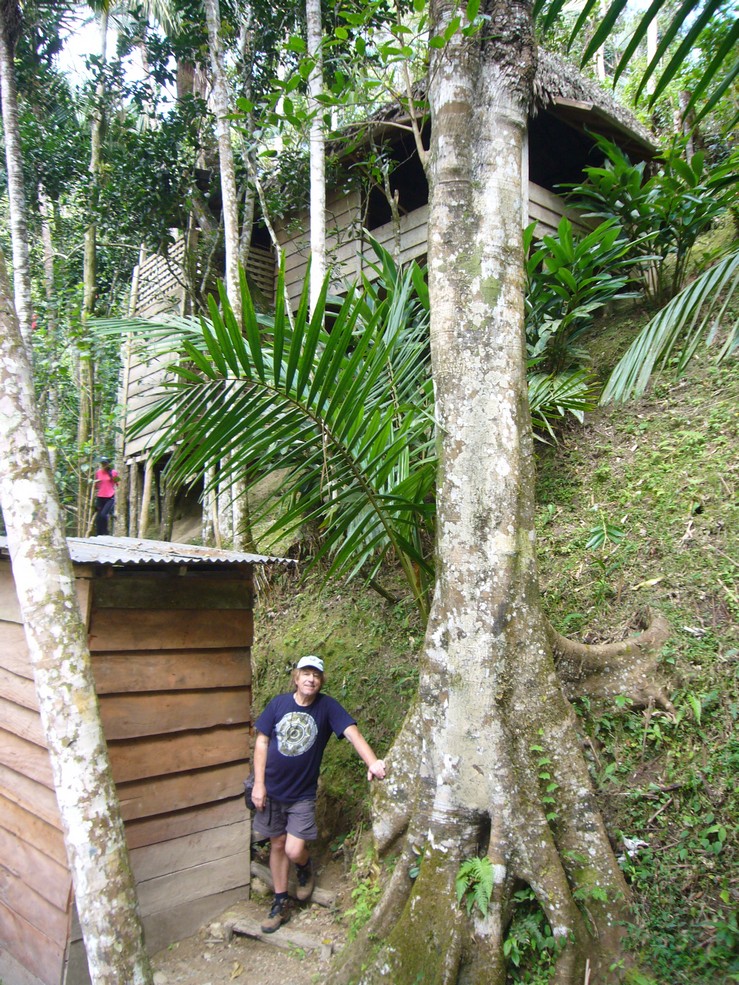
It is still amazing to think that a ragbag group of 12 Rebels with only a few weapons, went on to defeat Batista’s Army of 85,000 troops, from here.
We looked in at one more wooden structure, the administrative building, before beginning our return walk, stopping to take group photos.
Just before we arrived back at the vehicles, Raul spotted the State bird up in a tree – a trogon, beautifully coloured with white and red breast, black cap and blue wings. We watched for a while and I attempted to photograph it.
We felt pretty hot and sticky by now. Adrian had found it very hard going, with his lack of energy, but now we were driven back on the steep and bumpy roads to a so-called campsite, where we were to have lunch.
We sat at a long table, and were served an excellent lunch of chicken soup followed by chicken and rice. Not many enjoyed the ‘cheese and jam’ dessert, which is a typical Cuban dish.
Again a group of 6 musicians played for us, and we actually bought a CD of theirs, which pleased them very much. We gave them a lift back to their village as we were driven back to Bayamo, where Alberto had booked us a hotel for tonight, as he had been very displeased with last night’s hotel.
It was 1½ hour bumpy ride again, and we reached the hotel at about 4.45 pm. This hotel looked quite smart, and there was an enormous swimming pool, which a few of us made use of, even if it was a bit chilly!
Most of us had a meal upstairs together, where the best thing was the cookies, which tasted really good.
Saturday 2nd February Santiago de Cuba
Despite the strenuous walk and a swim, I didn’t sleep well! The foam pillow had an unpleasant smell, loud music went on until 1.00 am, and a mozzie bite was troubling me.
We went up for breakfast, which was just the same as supper minus the chicken and pork, except that this morning there was no tea (I went back down and got one of our tea bags for Adrian), no coffee, no hot water and no cups! After succeeding with most of these, we got ready to board the coach to travel to Santiago de Cuba, a town known amongst other things for its musical heritage.
We reached Hotel Versalles with its imposing hilltop position, at about midday. After lunch of ham and cheese/tuna sandwich, sitting with Annina and Kiki on a pleasant terrace, we all left in the bus to see something of the town.
Santiago is the second largest city in Cuba, and is like the capital of the east. It has connections with many famous names of Cuba.
Cuban transport!
We stopped first by Revolution Square, where there was a huge imposing statue of Maceo on horseback. It was extremely hot as we walked around.
We were then driven to Moncada Barracks, where on July 26th 1953 Fidel Castro led 100 revolutionaries against the regime of Batiste. The attack failed, and Castro amongst others was imprisoned for 15 years, but only served 2½ of these. There are still bullet holes in the walls.
El Moncada Barracks, with its bullet holes
Beni then tried to negotiate the small streets so that we could reach Parque Cespedes to begin a walk around the historical centre on our own. Our admiration of his driving was greatly increased, when one road after another was closed, and the only one we could take was half blocked by a water tanker. With help from the tanker driver and Alberto, he skilfully squeezed through!
After looking at the square, which has the oldest house still standing in Cuba by it (1522) and is also flanked by the cathedral, we wandered the atmospheric streets to Plaza de Dolores and back.
The cathedral in Santiago
There was a predominance of blue amongst the décor
We passed a gallery called Elvira Cape, so I had to have my photo taken by it.
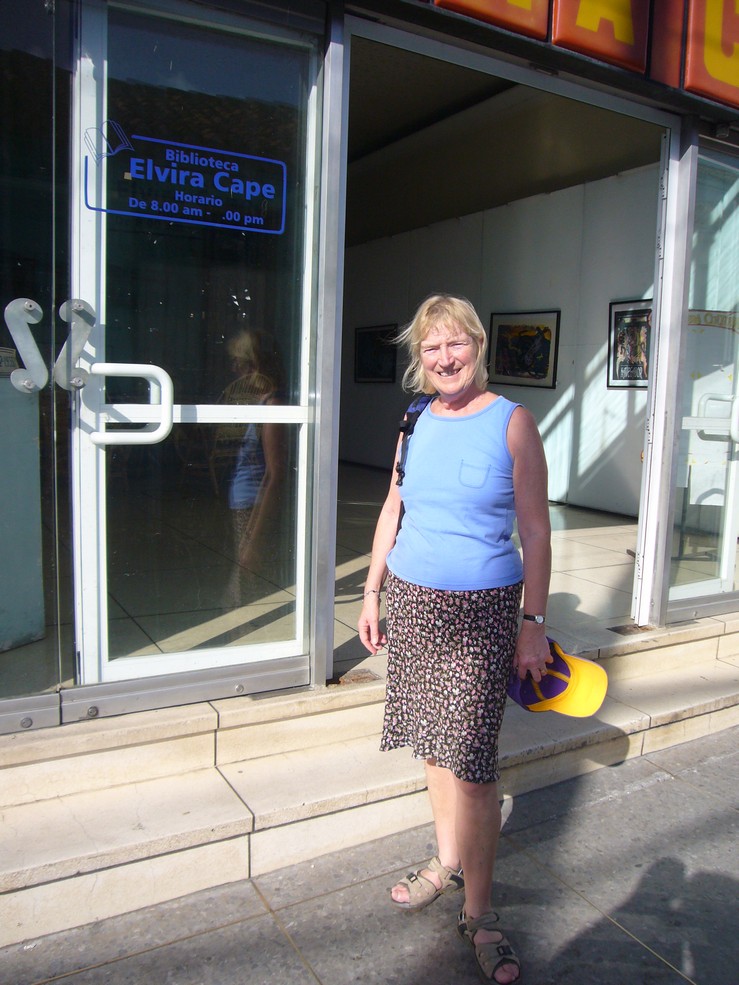
We also passed the Bacardi museum – Emilio Bacardi came from here, and the museum was founded in 1899. We ended up on the roof garden of Hotel Casa Granda, enjoying a mojito while we looked down on the splendid view above Parque Cespedes, looking to the hills and to the sea.
We were driven back to our hotel, where we had a short swim in the large and pleasant pool. An elderly gent supposedly from Venice, but living here for much of the year, got chatting to us.
At 7.15 we left for a meal at a very nice restaurant in the town, called Zunzun (hummingbird), near to where the Bacardi family had lived. We all sat outside on a terrace and enjoyed a seafood meal - prawns and lobster, with a nice pastry for dessert. A few of us went on to a music club in the town, where we listened to good music. Alberto tried to teach Kiki to dance Cuban style, and another woman joined in, and got both Simon and Adrian to dance!
Sunday 3rd February Around Santiago
It was already hot when I looked out at 7.00 am. In the courtyard nearby was a large iguana, and there were pink and white water lilies in the pond.
At 9.00 am we all left in the bus to see one or two sights around Santiago. We stopped first to try to get tickets for Tropicana for tonight – a Cuban show which would seem to be well known, but none of us had known about. The woman wasn’t there to get tickets, so we continued to El Cobre, a village about 20km from Santiago where copper had been mined until the late 1990s.
There was a large church here called Virgin of Charity, which has become a place where people bring offerings, as in many catholic communities. Being Sunday, a mass was taking place, but other parts of the church didn’t open until 11.00 am. We walked into the vast church – there was some good stained glass. We wandered up and down the neighbouring street, where there were stalls selling unattractive statues etc, and wreaths of sunflowers to offer as gifts.
Back at the church, where several tiny girls were dressed in immaculate frothy white dresses, we waited until we could join the hordes of people going up to visit the virgin, and then others who were making their offerings.
Outside young chaps were trying to sell us bits of copper from the mine.
While waiting, we had got chatting to William from Hong Kong. We’d heard that he’d been to Newbury, but now discovered that he had spent a year at the School of Military Survey in Hermitage in 1971!
We were now driven on to the huge Santa Ifigenia cemetery, where many important Cuban historical people have been buried. There were great marble vaults to Maceo, Cespedes and Marti. There was also one to Bacardi, and his wife Elvira Cape de Bacardi – now, we wonder if there is a connection there! So that’s who Elvira Cape was! (Rosie’s maiden name was Cape).
Every half hour there is a ‘changing of the guard’ at Marti’s great monument. We watched this, but I hated the Nazi looking marching of the guards.
Beni now drove us on to Castle Morro, the fort (dating from 1587) at the entrance to the bay of Santiago. The situation here above the sea was glorious.
After looking around, we booked a meal for us all for this evening in El Morro restaurant – apparently a haunt of Paul McCartney’s.
We arrived back at our hotel feeling pretty hungry, and made our way to the terrace bar. We ordered simple sandwich and pizza, but had to wait 1¼ hours for these to arrive. A glass or two of beer had helped pass the time!
There wasn’t much of the afternoon left now, but we did both have a swim in the pool before we all left for a meal at El Morro restaurant. We had plentiful seafood and beef, sitting in this beautifully situated restaurant above the sea, but it was too dark to see much. There was a chair with a plaque by Paul McCartney, who had eaten here in Nov 2000.
Several of us were then driven to Tropicana, to watch the show which started at 10.00 pm. It was a colourful extravaganza, but not our cup of tea at all! I hated the blaring music, and we both felt that it was very amateurish. We weren’t impressed by the dancing, the singing or the lighting. Although there were some magnificent costumes, my impression was that the talent was missing, so show some bare flesh! The women’s costumes almost all had a bikini-front, with just a g-string up the back.
A further annoyance was that the group of men in front – apparently past baseball heroes – smoked a lot, and one of them stood up constantly to take photos, blocking my view! We were relieved when the show ended, and Beni was there to drive us back to the hotel.
Monday 4th February Past Guantanamo Bay to Baracoa
We left on the bus at 9 o’clock to be driven to Baracoa, in Guantanamo Province. Alberto played the song Guantanamera, which means a peasant woman from Guantanamo. The words of the song were written by Jose Marti in the 1880s, but the melody was written by Fernandez in the 1940s. He had made the song popular, and was singing on the track we heard.
We stopped for coffee in the town of Guantanamo – rather an ugly place with Russian style apartment blocks. Our route now went past the American base at Guantanamo Bay, but it was in the distance and we were not allowed to stop, or to take photos. It was a weird and eerie feeling to be here.
The road now followed along beside the eastern end of Cuba’s south coast, with some splendid scenery, especially with the turquoise sea.
We stopped to photograph, and found that we were on an area of fossilised coral, so our stop was longer than intended while we marvelled at the formations in the rocks we were walking over. With large cacti, and limestone cliffs inland it was a lovely drive.
We now had to drive inland over the Sierra del Puri mountain range to Baracoa, on a road known as La Farolla, which was finished in the 1960s.The road wound up through forested wilderness, over the Alto de Cotilla (600m). We stopped at a viewpoint, where locals were selling their wares – local coffee, cocoa, chocolate, and necklaces made from the local colourful snail shells.
Near here we gave a lift to 2 small girls, aged 8 and 6, who were walking to school along this winding mountain road.
Finally we descended to Baracoa, the oldest town in Cuba, dating from 1511. We had to drive right through the town to our hotel – Porto Santo – which is in an idyllic position right above the beach, and looking across the bay to the town. We were given a welcome drink while our rooms were being sorted, and then we ate a late lunch of cheese/ham sandwich and a beer.
No time to stop, as it was back on the bus to be dropped in Baracoa to see the ‘sights’. Traditionally, Christopher Columbus was the first to come here, in 1492, and we stopped by a statue to him, and a large wooden cross like one he had put in the ground here (Historians now say he probably landed in Holguin province).
Christopher Columbus landed here! (N.B There are no paintings of Columbus - so some imagination nequired)
The town of streets of crumbling houses is the most dilapidated yet, but had a certain charm, and yielded many photos! The streets were busy with locals walking, or on a variety of old vehicles – bikes, bike taxis, scooters etc.
There was a poignant statue to a 16th century Taino Indian chief called Hatuey, who had led a rebellion against the marauding Spanish. They captured and tortured him, and the story goes that a priest offered him a cross, and asked him if he would like to become a Christian, and go to Heaven. He reputedly replied that if that is where people like the conquering Spanish went, with their cruel ways, he didn’t want to know. He was then burned at the stake.
We were driven back to our hotel, where we have seaview balconies, and I immediately made for a short swim in the beautifully situated pool. We were intrigued by the number of people working on smart cycles at the hotel, and discovered that tomorrow is the start of the ‘Tour de Cuba’ cycle race, and the competitors are staying here too.
In the evening we were all driven down into Baracoa, where we had a meal in El Colonial restaurant, eating seafood once again (fish/crab). The town was very lively as we walked through. Back at the hotel we sat at the bar above the sea with Kiki, Annina, Brian and Simon.
Hatuey
Tuesday 5th February Enjoying the country around Baracoa
I was just in time to see the sun rise at 6.30. We were aware that it was Shrove Tuesday, but all we had to commemorate it was some tough little pancakes as part of the breakfast. Mardi Gras isn’t celebrated here.
This was our free day, but Alberto had arranged for us to have a walk through the surrounding countryside. Beni drove us a short distance, and then we had Rafael as our guide, accompanied by his horse Tiburon.
It was a delightful walk, far more relaxed than the one in the Sierra Maestra, and much more enjoyable for Adrian now that he is feeling a lot better.
The horse was needed as we had several river crossings to make. Only Annina was a keen horsewoman, but at the first river crossing it was me who followed after her.
It took a long time for all 15 of us to cross the river on horseback, and Rafael had to cross 30 times in total.
Later both I and Adrian had a ride as the others walked along, and Adrian was still on horseback when we stopped for a group photo with flat topped Anvil Mountain in the background.
At the second river crossing, several people waded across, including me, as I’d brought along my water shoes.
The walk went through areas of palms – banana and coconut. The locals cut down coconuts for us and we drank the milk and ate the soft flesh. One of the men shinned high up a palm to knock down coconuts.
At another dwelling, where the man was sweeping his earth yard clean, we were given ripe bananas.
We passed a tiny school with just 3 pupils, and were invited in to take photos. There was a ‘mini library’ at the back of the classroom, a computer (run on solar cells) and a Cuban flag and statue of Marti outside (like all schools).
I was sorry not to see many birds (we did see some anis), but often the tropical jungle was covered in Black Eyed Susan flowers. We saw breadfruit trees, cocoas and mangos. I also saw a tree with spiky red fruits resembling a lychee. Alberto told us that it is used as a saffron substitute.
The walk ended at a last river, where several of us had a refreshing swim, being washed down by the strong current.
We’d crossed to the far bank, where locals were about to roast a hog. They also had some Baracoa chocolate to sell, and we bought some. Beni had arrived with the bus, and drove us back to the hotel. It had been a lovely morning.
Now we had some free time, so after our beer and sandwich lunch, we walked down to the little sandy beach below the hotel. There was a lot of attractive seaweed with tiny little ‘grapes’ on it. The water was warm, and after a while, I couldn’t resist a swim, although I hadn’t come prepared! Eileen and David had arrived, and us 2 ladies did some ‘South Pacific’ impressions!
By the time we got to the pool later in the afternoon, the sun was about to go, but we did both have a swim.
We had a meal at El Colonial again – reputedly the best eating place around. I had octopus and Adrian had shark. We’d hoped to go on to the Trova, and actually went in and sat down, waiting for the musicians to start up, but most of the others wanted to go back to the hotel, so we were outnumbered. Back at the hotel a few of us sat at the bar for a last drink in this lovely setting.
The little beach beneath the hotel
Wednesday 6th February North to Holguin
This is Chinese New Year, so I attempted Gong Hay Far Choy (or something like that) to the Hong Kong people in our group.
We were all early for our 8.00 am departure to Holguin. It wasn’t that far in distance, but the road was really bad, so the going was extremely slow. We were further hampered by problems like pigs on the road!
We were sorry to leave the lovely situation of Baracoa. We travelled northwards up the coast, crossing the wide Toa River, the largest in Cuba. The vegetation was lush and tropical. We had glimpses of the turquoise sea to our right, and limestone cliffs to our left.
We crossed into Holguin Province, and soon came to Moa, a nickel producing area, the 6th in the world. It was very ugly – the least said the better. Lonely Planet sums it up by saying ‘important economically, and horrendous ecologically’. Quite.
Approaching Moa
It was 10.00 am when we stopped by the small airport in order to use the toilet facilities and to buy drinking water, as Beni’s supply had run out. Everywhere was closed up. A woman was sitting by a table, blocking the way into a room where there were toilets beyond. I asked her for ‘Banos’, and had to almost climb over the table! We were unable to get any water, so we drove on to a petrol station, where we did succeed, and I had a small coffee too.
As we continued northwards, the countryside became drier. We stopped just before Sagua de Tanamo where men were washing horses (and themselves) in the river.
We finally reached Holquin at 2.30. It had been a long drive for Beni, with virtually no stops.
We were booked into Hotel Pernik, which, as Alberto said, was like a Russian block, but at least the entrance lounge was pleasant, and there were plants growing everywhere. We couldn’t make our room key work – and the room hadn’t been made up anyway, so we went to the poolside café for a late pizza and beer lunch before being driven back into Holguin.
This town hadn’t the charm of others we have visited. It is known for its many squares, and we walked around several, and visited a couple of churches. The cathedral had a statue of the pope outside, but when the pope came to Cuba, he didn’t make it to Holguin.
Plenty of English 50’s cars about
We had one real delight though. Nearing decrepit Plaza de la Marqueta, we could hear classical music, and on looking into the ruins of the central once-grand hall, we saw two ballerinas practicing. They were quite wonderful, and I was really moved by the vision of them performing in this weird setting, with bicycles propped around, and just a handful of onlookers. Apparently the square is being slowly restored to become a great art centre. We knew, as we watched, that this was real talent, and that ‘Tropicana’ was just popular rubbish.
Prima ballerinas rehearse in the ruins of a once grand hall
When we got back to the hotel, I made straight for the large pool for a swim. We had hung around in Holguin, waiting for a couple who had already gone back to the hotel, so time was a bit short.
As it was Chinese New Year, the Hong Kong contingent plus Kiki and I dressed in something red. We ate at a smart restaurant where we had a private room, but the tables were divided up. The speciality was stuffed chicken breast, and we both drank a glass or two of white wine.
Thursday 7th February A long journey to Santa Clara, and Che Guevara
We set off at 8 o’clock again, as we had a long way to go! Alberto showed us his accounts of the tipping kitty, and we sorted out a tip for Beni, who has driven us so carefully on all these long drives.
We have seen people transported in all sorts of trucks, but the one we saw today, with just a narrow slit opening at the rear and sides filled me with horror. We can’t help feeling guilty when we travel in comfort, while the Cubans have to wait at the side of the road for ages, in order to get a lift.
We stopped at Las Tunas for a ‘loo stop’, as we had done on our outward journey. That time several men were trying to erect a statue of Marti. Today it was in place, and looked fantastic. A man was putting finishing touches to painting it. We couldn’t have believed it was the same statue.
Putting the finishing touches to Marti
From here we were taking the same route as before, back to Camaguey and on past Ciego de Avila.
At one point we had to stop while a group of genuine looking cowboys herded a herd of cattle along the road.
We had a pleasant lunch stop at a place called El Oasis, and it was just that! We ate good toasted sandwiches and shared a beer. The toilets were exceptionally clean, with fresh flowers, and a man was sweeping the ground under the shady trees.
The last ¾ hour’s travel was on the so-called motorway, but there was mostly only one carriageway, and when there were two, one was being worked on, so the route zig-zagged from one to the other.
We reached Santa Clara at almost 5.00 pm, and made straight for the museum and memorial to Che Guevara, which would soon be closing. This charismatic man is an icon in Cuba, and there are images of him all over the country. No cameras are allowed inside the memorial, and the place is under close surveillance. There were articles from Che’s life – from things he had written as a child to guns he used as a revolutionary. There were numerous large photos too – I found it all quite moving.
Statue of Che and the letter he wrote to Castro
The memorial room had pictures in front of the graves of Che, and the other revolutionaries who died in Bolivia, each with a fresh gladiolus flower beside it. An eternal flame was burning. Che’s remains had been brought back to Cuba from Bolivia, where he had been killed in 1967 (by the CIA), in 1997.
Outside there was a large statue, with the letter which Che had written to Castro, to be read after his death, engraved on a large stone pillar.
Alberto and Beni
We were driven on to Los Caneyes hotel, and while still on the bus, made a decision about our leaving time tomorrow, as 3 of the group are leaving from Havana in the afternoon. We made the decision to leave early at 8.00 am, and not spend more time exploring Santa Clara.
It was after we had got off the bus at this pleasant hotel of individual cabins that we had the blow of finding that Brian’s bag hadn’t arrived. There had been some confusion at the hotel this morning between two coaches leaving together, and we can only think that Brian’s bag got onto the other bus.
Having eventually got to our ‘jungle cabin’, I made straight for the pleasant swimming pool.
We had excellent food for our meal in Santa Clara, eaten in an old colonial courtyard. The waiter had a jovial round face. We had prawns, lobster, pork and chicken, and delicious warm banana chips. We all walked into the square and sat outside at a bar. Annina and I had mojitos.
Friday 8th February Back to Havana
We were all ready for breakfast when they opened at 7.30, but I made sure that our bags were on the bus first, after the disaster with Brian’s bag. The food selection was good – they even had quail’s eggs, which I tried - but the place was very busy – apparently the hotel was overbooked last night.
We left at 8 o’clock as planned, taking the so-called motorway to Havana. With the railway line crossing the road at one point, and vendors by the road selling their produce, mostly cheese, it was a far cry from our motorways!
We made one loo stop, where we had stopped when on our outward journey. The coffee here cost $1.50, as opposed to 25 cents ‘up country’. Beni now headed for Havana airport, reaching it in good time for Angela, Simon and Annina to get their flights, so we said our goodbyes.
As we were going close to the Viazul bus station we stopped off and Alberto came in with us to book our tickets for Varadero on Sunday.
After that we stopped by the vast Plaza de la Revolucion, with its huge monument, and statue of Marti.
Plaza de le Revolucion
Now it was time to make for the Plaza Hotel, where there was some delay, as our room wasn’t yet ready. In the end we put our bags in the room, and went down to the café where we sat with the others and had the ubiquitous beer and sandwich lunch.
We had 20 minutes left on our internet card for here, but had quite a saga using it. Firstly Adrian was trying to use the card we had bought in Trinidad, which had expired. By the time we had searched through our luggage and found the right card, all 3 internet computers were being used. We decided to go out around the town and return to the internet later, which we did. We were then able to read and reply to Simon and Emma, but had a very confused message about our proposed trip to Antarctica next January, saying that basically we have no booking.
It was very hot waking around Havana, and having taken so many photos before, we didn’t need to this time. We made our way to the Plaza Vieja, where we located the access to the camera oscura. We took the lift to the 8th floor, where we had good views of Havana, but then we went into a small room where there was a white upturned ‘dish’ on which we saw images of Havana below. The lady moved lens above around, which moved the image on the dish and so gave different views.
Back at ground level, we wandered along the old streets we had walked a couple of weeks ago, and stopped by an old 1900 Presidential railway carriage built in USA, and now standing here for some reason! We made our way to Plaza de Armas, where there were dozens of stalls selling old books. Adrian bought a National Geographic magazine of 1924 for 4 cuc with an article on the Hawaiian Islands in it.
We walked to the harbour edge, and seeing a cocotaxi close by, fulfilled our wish, and had a hair-raising ride back to our hotel.
In the evening we all walked once more to Ambos Mundos, the hotel which Hemingway had frequented, and ate a good meal, sitting on the roof terrace. We had a selection of prawns, fish and meat, with a fruit cocktail first, and drank a mojito, followed by a beer.
A cocotaxi ride at last
Saturday 9th February Last day in Havana
It was nice not to have set the alarm! After breakfast we all met in the lobby to say our goodbyes. Alberto would be travelling to his family’s home near Vinales for the weekend, before he started on another tour (a ‘Honeymoon tour’ for a German couple) on Monday. Others were flying home today, but a few of us are staying in Havana for another night.
We were booked into the Hotel Lincoln for our last night, so walked there to check out that our booking was OK, after our previous problem with hotels here.
We were told that our room was ready, so we walked back to the Plaza, and collected our luggage before taking a taxi back to the Lincoln.
Goodbye to Alberto
A band played, including 3 grandsons of the man Alberto had played to us, singing ‘Chan Chan’. At 9.00 pm, a cannon was fired from the fort across the water.
We all walked back, and retired to David and Eileen’s large room for a farewell ‘party’ with rum and coke.
Having settled into our room (we could see the sea from our small balcony, and stood on it long enough to take a photo, but didn’t trust it any longer!), we took another taxi to Lennon Square. In this square is a statue of John Lennon, sitting on a park seat. Beatles music had been banned in the 60s, as being too decadent, but later Castro had liked John’s revolutionary ideas, and in December 2000, on the 20th anniversary of John’s murder, he had unveiled this statue to him. We took our photos, and an elderly gent, who we took to be the ‘guardian of the statue’, took one of the two of us. He then produced CDs of John Lennon and Cuban music from his bag – we brought one of the latter.
View from the entrance of Hotel Lincoln
Our drive here had given us a chance to see something of Vedado, the modern part of Havana, with a smattering of high rises. There were also some pleasant houses in shady streets. We walked back to the water’s edge before getting a taxi back to the old town.
We had a lovely time wandering around, soaking in the vibrant atmosphere of ‘Cuba on the streets’. We walked through the many craft market stalls. One section was devoted to art work – we have been really impressed by the diversity and high standard of the art in Cuba.
It was nice to be wandering past places we had visited on our earlier time in Havana, without the need of taking photos. We stopped for lunch at an open air restaurant – rather upmarket. I had prawn and fruit salad and Adrian had 4 cheese pizza – both were excellent, and were washed down with beer/mojito. Music was provided by an Afro-Cuban lady with a lot of curly hair. After each piece of music, she applauded herself, and said how good it was!
We continued wandering along the narrow, busy streets, hoping to find a stall selling Che Guevara T-shirts, but were out of luck. We did bump into David and Eileen, who were about to leave for the airport.
We felt hot and sticky when we arrived back at the Lincoln. We’d heard that the water is never warm at the Lincoln, but a cool bath didn’t sound too bad. The bad part was that when I took the plug out, water flowed all over the floor!
We walked back to the Plaza to meet up with Kiki, Wendy, Jim and Heather and all walked to the restaurant with the Cuban flamenco dancing which we had visited on the first night with the group. The restaurant was empty when we arrived, but soon filled up, and we were treated to another night of this vibrant music and dancing, and actually bought one of their CDs.
Sitting with John Lennon
We ate the skewered seafood/meat again while we enjoyed the warm atmosphere.
The flamenco again
We walked back, and said our final goodbyes to the others (we thought!) before walking back through the noisy streets to the Lincoln Hotel.
Rosie, Kiki, Wendy, Heather and Jim
Sunday 10th February Goodbye to Cuba – we can even make it rain here!
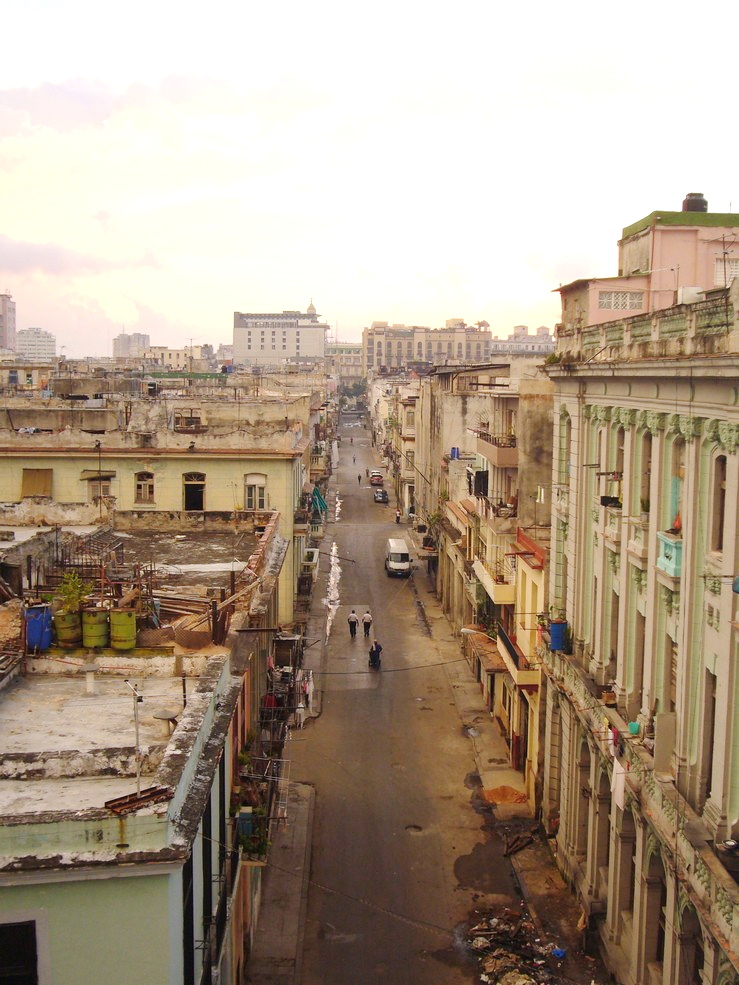
We woke at 7 o’clock to see the sun rise over the skyline into an angry looking sky. We had heard that it might rain today, and it certainly did! All hell let loose with a mighty storm with thunder and lightning, and soon the streets were awash.
As breakfast was served on the roof terrace, with little protection from the rain, there were difficulties! Some people sat at tables along a corridor inside, but this wasn’t very pleasant, so we sat at an outdoor table beside the wall. The food had suffered from the rain, so it wasn’t the best breakfast! There was an inside restaurant which isn’t in use, but no-one thought to use that!
When the rain appeared to have stopped, we walked back to the old centre as we wanted to buy Ché T-shirts from a shop which Kiki had pointed out. We reached it just as it started to pour again, and found that it didn’t open until 10 o’clock, being Sunday. It was now 9.15, so with no other bright suggestions, we decided to go into the Plaza lobby for me to have a coffee. While in there, we met up for the real last time with Jim and Heather and with Wendy to say goodbye once more!
The good news was that we did both buy a T-shirt, although the lady told me, as she had Kiki, that mine was a child’s! As it was still raining hard, we said ‘yes’ to the first person who asked if we wanted a taxi. He agreed to take us back to the Lincoln to collect our bags, and then on to the bus station. His car was such a decrepit old thing, that we wondered whether it would make it!
The rain was really hard again by now, and everywhere had become flooded. When we reached the bus station (with some relief!), the driver followed us in to ask if we wanted him to take us on to Varadero! There was no question about that, and when we saw the many stranded cars while on our bus journey, and a jack-knifed lorry, we were glad to be in a comfortable bus!
We’d booked in our bags at the bus station, like at an airport, so Adrian watched carefully when the bus arrived to make sure that they went on! The 12 o’clock bus left on time, and more lightning flashed as we continued eastwards to Varadero. We stopped once, as we had done on our previous journey, and we were able to buy a ‘sandwich’ for lunch. By now the rain had stopped. We arrived at Varadero airport, and having paid our departure tax, spent our last bit of Cuban money on a hat for Adrian.
In the departure lounge, I heard our names called out, and on enquiring we were told that they had omitted to note something from our passports, and needed to return them to be checked. We weren’t happy about this, but all was well, and everything went smoothly for our 5.00 pm departure to Calgary.
We were able to look down on Florida Keys and the coast as we flew north, but it soon became dark. I watched 3 entertaining films – ‘The Bee Movie’, ‘Mr Magorian’s Wonder Emporium’ and ‘Dan in Real Life’.
As we arrived at Calgary, we looked down to the freshly fallen snow. After landing and collecting our bags (first one off!), Simon met us and drove us through the snowy streets (-17°C) to their house. Now 10.00 pm (midnight to us) we were ready for bed! The welcome warm duvet was in great contrast to the cotton sheet of the past 3 weeks!
View from our window just before the storm
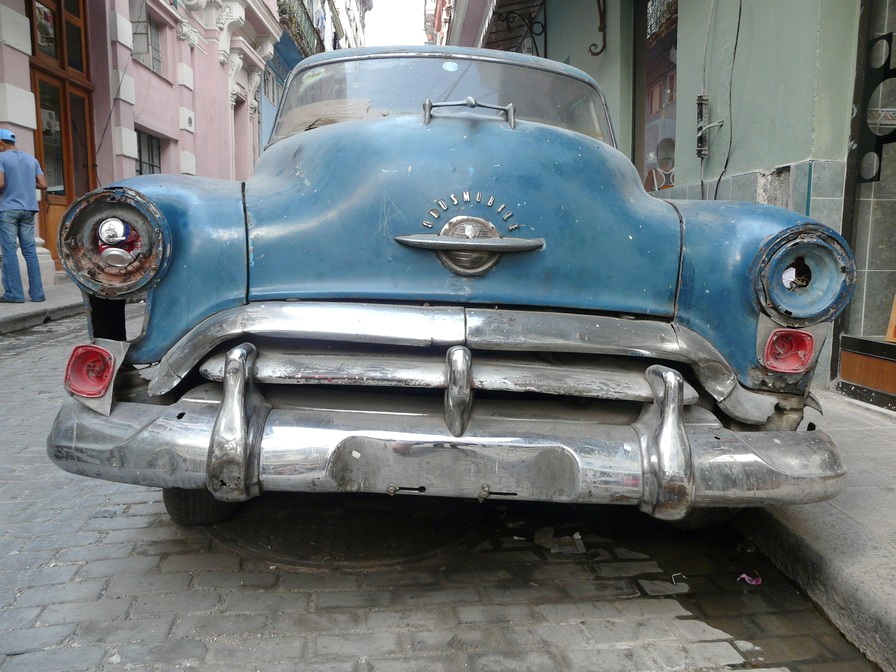
'Taxi sir'
Monday 11th – Thursday 21st February
We enjoyed the next 10 days in Calgary, where the ground was snow-covered, but the sky mostly blue.
Simon and Laure’s birthday present to me was a night in a hotel in Banff. This we enjoyed very much, especially the open air spa pool.
In our spare moments, we finished our website on Cuba, and sent our email just as we heard that Fidel Castro had officially stood down.
Our flight home seemed rather long, as we had to land at Glasgow again, which this time looked wet and windy. Simon had dropped us early at Calgary Airport, as he had a meeting.
While on the plane, we saw a total eclipse of the moon – a splendid sight, but marred by the flight attendant telling us to go back to our seats.
It was 8.00 am when we landed at Glasgow, and the flight attendants spent ages fussing over the hand luggage still left, counting it and the passengers several times.
I then dozed as we continued to Gatwick, where we landed at 10.00 at a far flung corner of the airport, and had a long bus journey back to the terminal. We still had to wait ages for our luggage. By 11.00 we had our luggage, and headed out to wait for the 11.45 bus to Reading. I slept all the way, waking only to see some welcome daffodils. The weather was raw and cold as we caught our taxi to Hermitage, where we busied ourselves unpacking and preparing to leave next morning for a few days with Emma, and then with Paul and Nicky, to celebrate our joint birthdays,
In Banff we visited the Banff Springs Hotel, which we had never been in before, and experienced a wonderful sky by the almost completely frozen Bow Falls.

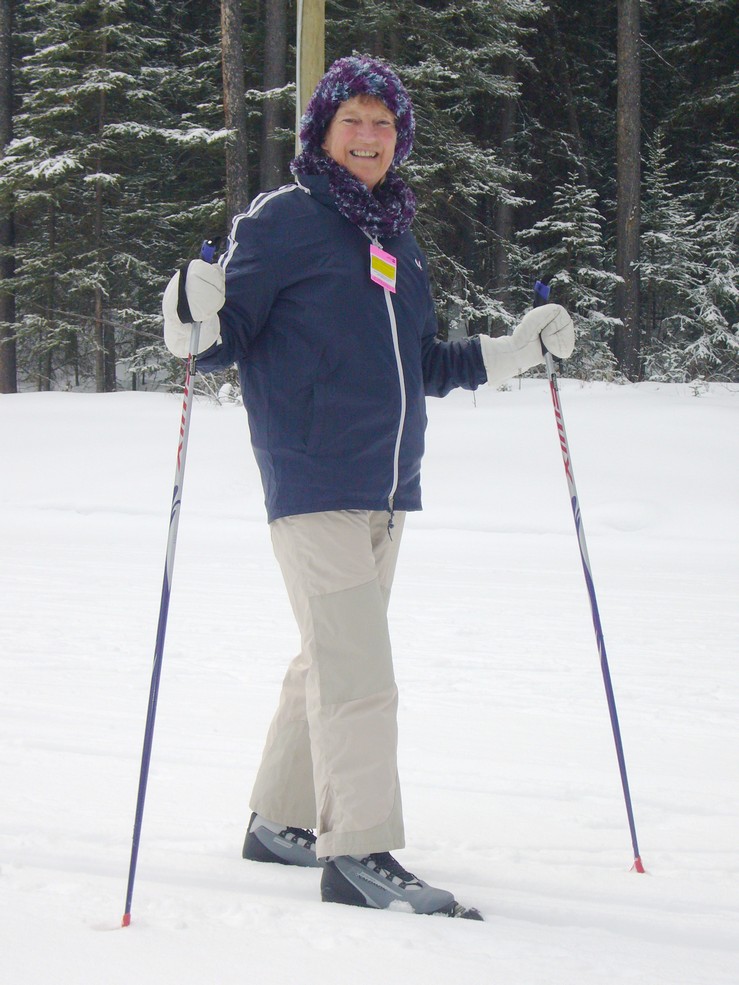
On our cross-country ski at Canmore
On the way there we stopped at Canmore to try cross-country skiing for the first time. We got on better than expected, and completed the 5.5 km circuit.
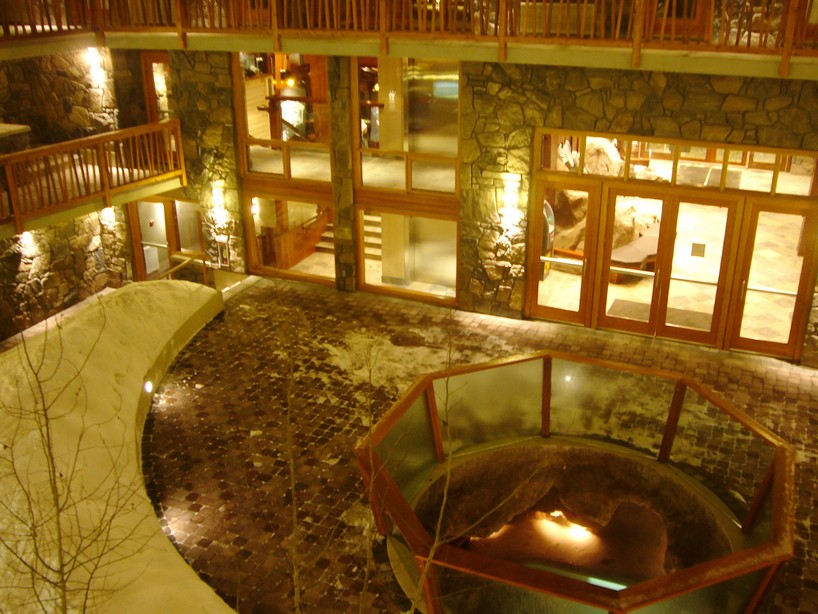
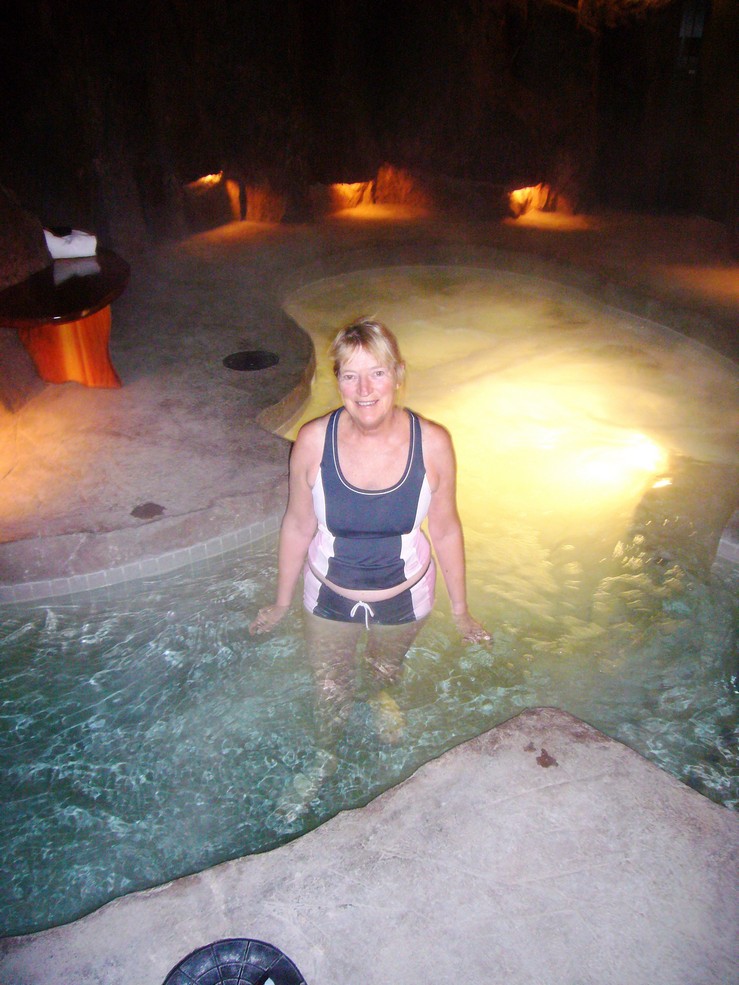
The Fox Inn (pool below octagonal rails) and Rosie in the pool
In the morning we took the gondola up Sulphur Mountain and had a walk out across the snowy and freezing landscape.
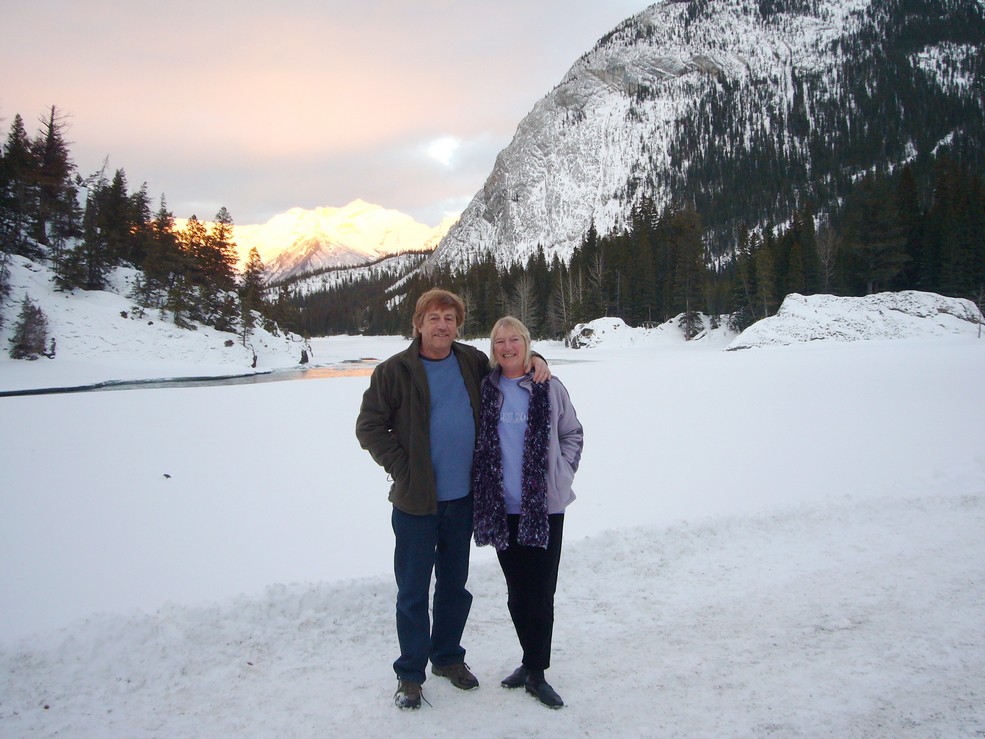
We had a lovely time looking after Manolo while Simon and Laure had a couple of days at Lake Louise. Just as they returned, David Barlow, Nicky and Izzy called in having just landed at Calgary for a holiday.Manolo loved his many trips to the park with the large trucks, and also had a good time when we took him swimming.
On the frozen Bow River
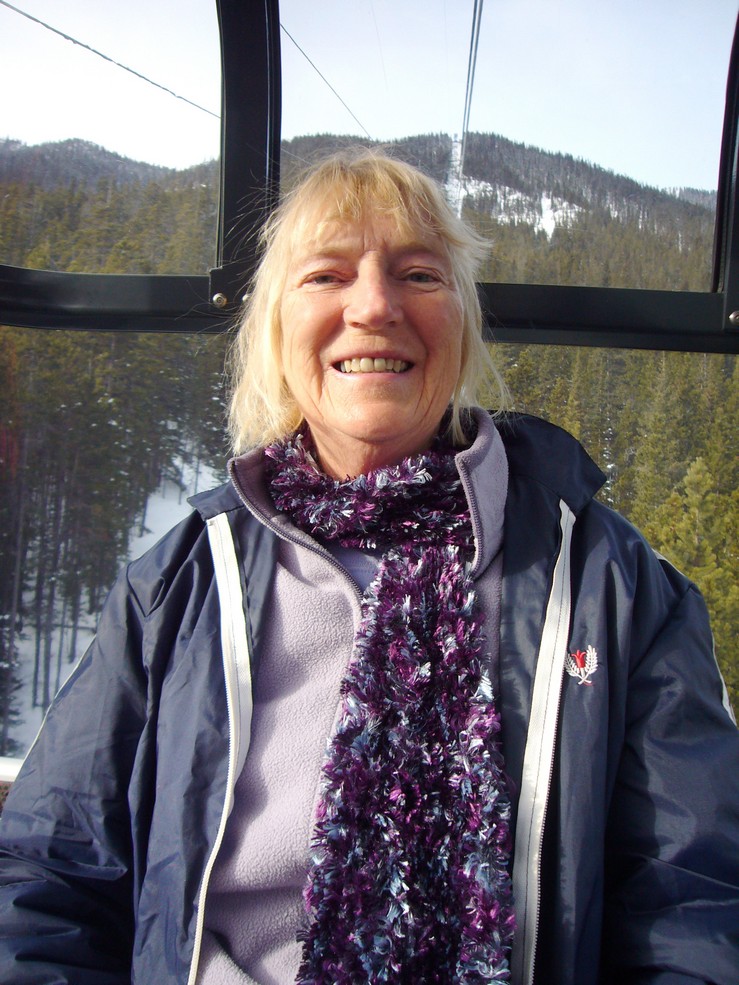


On the gondola up Sulphur Mountain
View from Sulphur Mountain
We both enjoyed a walk down to the snowy Elbow River with Simon.

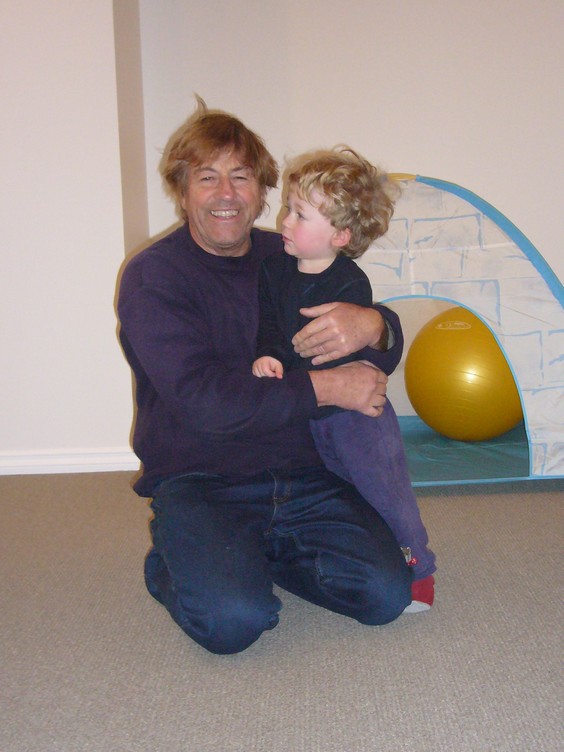
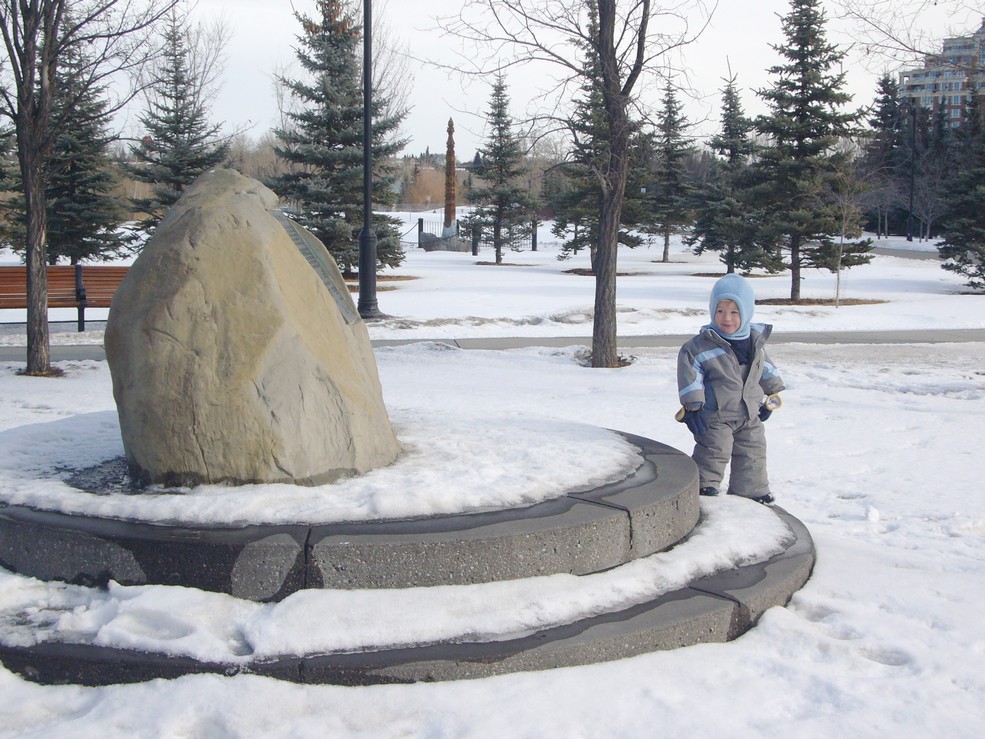
Manolo having fun

By the Elbow River
Cuba
Highlights
Day in Matanzas with the Yells
Café del Chef, Varadero – drinks and music
Viñales – friendly town, mountain scenery, early morning drive.
Caie de Jutia – and experiencing the roads!
Liveliness of Havana.
Watching ‘Nutcracker’ in the Grand Theatre.
Cuban flamenco restaurant
Walks – Sierra Maestra – to Castro’s headquarters.
Around Baracoa – horse riding, rivers and lush vegetation
Many meals with musical accompaniment, epitomised by the one at the Campismo, where we bought their CD.
Holguin – ballet rehearsal in ruined hall.
Impressions of Cuba
Many lovely buildings – a lot decrepit
Vibrant – wonderful music and art
Very little maintenance done
Prolific number of old cars (plus a few new ones)
Everybody friendly, but most ‘on the make’
Weather mostly hot and sunny (rain at beginning and end if trip)
Food! Cheese/ham sandwich or pizza. Rice and beans. Little variety.
Dual currency problems
People well dressed and generally happy.
Lack of incentive – disinterest in giving service
Much rocky limestone coastline, with few sandy beaches
Transport problems – ‘hitch hiking’
Many bad roads.
Images of Ché everywhere
All CDs are copies
Very little in shops
Not as much wildlife as expected
Fields of sugar (or previous sugar plantations)
Tobacco and cigars – a lot of smoking
Uniformity and ugliness of buildings – schools, hospitals etc, dating from the Russian era.
Lack of free enterprise noticeable.







